

Should you Include Headings and Subheadings in an Essay?
If you have ever tried reading a large blob of text, then you know how hard it can be. However, it becomes easier to read when broken into headings and subheadings.
Academic writings like essays have a standard of writing that must be upheld. While not every essay requires headings and subheadings, they are important for organizing your writing.
Headings describe the succeeding section, while subheading gives supporting information for the heading.
With that said, here is everything you need to know about headings
What are Headings in Essays and Academic Papers?
According to Merriam-Webster, a heading forms or serves as a head.
In academic writing, headings represent what is to come in the assignment. Adding a heading will help structure a piece of writing and guide the reader throughout the content. Short pieces of writing don't always require headings. In long-form writing, each specific section should have its heading to communicate what the reader should expect clearly. Think of it as the title of that section.
Since some points are more important than others, the heading chosen should be based on whether the idea you are talking about is the main point. Each heading chosen should tell the reader what the following idea is about. This is because the main points are the building blocks of the content. Make sure it is short, descriptive, and precise.
You can include headings and subheadings/subtopics in an essay if it is long, but ensure that the subtopics or subheadings are relevant to the content and consistent throughout the text in a manner to contribute to your thesis statement. As a good practice, ensure that the essay headings and subheadings do not exceed 12 words.
Subheadings are not recommended for short essays . However, they improve the overall structure of a long essay, help you frame and explore your topic, and enable the readers to know what to expect (they act as signposts in an essay or research paper).
Heading vs. Title
Headings and titles may look similar at a first glance, but they are not. A title represents the entire paper and explains it in clear and short phrases. It is the first thing the reader will see and determine whether they read the rest of the document. For this reason, you need to think of striking, informative, and appropriate titles. You should also write the title based on why you are writing that document. For instance, if the aim of the documents is tutorial, then the title should be task-based.
On the other hand, a heading represents what each section of the paper discusses. They help guide the reader throughout the documents, which is why you should write effective headings, and they should be as descriptive as possible.
Headings are a requirement in most forms of writing, but some lecturers may be divided about using them in academic essays, which is why you should confirm with them first.
Headings Vs. Subheadings
Headings are key parts of writing as they will capture the reader's attention and lure them into the document's purpose. They guide the reader to the main points of the paper. You have to set the headings apart from the body of the text by coming up with an enticing phrase.
Subheadings, on the other hand, do more than grab the reader's attention; they show the different subsections of the text. They keep the reader engaged by quickly guiding them to the information they want.
Headings and subheadings appear at the beginning of a section and organize the flow of the documents. In addition, they are both used to break down large blocks of text to make them more scannable. They also have a hierarchy that is Heading (H2) first, followed by subheadings (H3) and (H4) in that order. Subheadings should always come after the heading, as demonstrated.
The Best Length for Headings in Academic Writing
A heading can be as long as you want it to give the reader a snippet of the idea. A good rule of thumb should be no more than 70 characters.
For higher level headings, like H1, H2, and H3s, they could be as low as one word, for instance, the introduction, methodology, and such. For such sections, the one word is clear enough for the reader to know what it represents. Low levels like H5 and below can be much longer and direct the reader to exactly what they are looking for.
Levels of Heading in Academic Writing
Headings are an important part of academic writing as they act as a preview of the document. They guide the reader on what you are talking about, which is why you should assign different heading levels.
There are five levels of headings in APA style. Level 1, Level 2, level 3, level 4, levels 5. Level 1 is the main heading, followed by level 2, its subheading, and level 3 is the subsection of level 2 in that order.
Level 1 headings are your main headings and are usually typed in the center of the paper in title case and bolded. Their text beneath will always start in the next line, indented inward, just as you begin a new paragraph. These help the reader find their way through the document, read what they want and skip what they are not interested in.
The length and complexity of the paper will determine how many levels you will use. If it's just a short piece of writing, you can use Level 1. If you need two headings, use level 1 and level 2. If it's a 2000-word article, research paper, term paper, or essay, you will need between 3 and 5 headings.
Keep in mind that not every paragraph needs a heading. While headings can keep your work neat, too many can defeat the purpose. Also, make sure that each of the headings and subheadings has a connection to the main title.
All these levels are differentiated by different styles and formats depending on the publication manual provided, which can be either APA or MLA format.
Reasons to Use Headings in Academic Writing
Headings are helpful in academic writing for a myriad of reasons, including:
Making Your Content More Readable
Much information goes into academic writing to pass information to the reader. Putting all your information in a large block of text will be overwhelming and can scare away the readers. The white gaps at each heading section will offer a resting place hence a visual break. Therefore, separating the large chunks of text into manageable portions will keep your readers engaged.
Outlining Your Content
Headings serve as the structure of your writing. By dividing the large bulk of text with headings, you guide the reader through each section and what it is about. Otherwise, they won't know what it is about.
Capturing the Reader's Attention
The main aim of any heading is to hook the reader and create curiosity enough for them to continue reading through the rest of the article. Having a catchy and informative heading will entice them to read even further.
Remember that readers rarely read documents from start to finish. Major headings should stand out but so should headings and subheadings if you want the readers to continue reading your paper.
Finding Important Information
Readers will likely scan the essay to get a general idea of what it is about and decide if they want to read it. Well-structured headings will help them achieve that.
Improving Overall Quality
Headings and subheadings improve the quality of the essay. A high-quality essay is suitable for readers and also for search engine optimization (SEO) if you intend to publish it online. Ensure to use keywords in the headings and structure them to improve visibility.
Tips to Include Better Headings and Subheadings
Writing informative and precise headings and subheadings is vital if you want your writing to get the message home. You need to borrow the following tips to show that they should spend time reading your writing.
Use the Right Length
The length of your article or essay will determine how long your headings and subheadings should be. Put yourself in the reader's shoes and think of the heading you would like to read. Lengthy headings aren't attractive. Most readers want something short and precise, which is what you should do. It should only take them a few seconds to read, so be sure the length should be not more than 30 words.
Make It Relevant to the Content and Topic
Headings and subheadings are essential to catch the reader's attention but are not important enough to stand independently. They represent the critical concepts and all the supporting ideas. Therefore, you need to consider the topic's relevance when determining what phrases to use in your subheading. Carefully think about each key piece of information you'd like to include in each of your sections. Then ensure that each subheading is connected to the main title or the heading.
Be Clear and Concise
Headings and subheadings tell the reader what the content is about. They are usually about five words long. Therefore, you should go directly to the point using clear language that is easy to understand. Most readers skim through the text before reading which is why you should use simple and straightforward words. Always remember that readers have questions and are looking for answers and shouldn't have to ponder what you are talking about. If your heading is clear and to the point, they won't leave to look for answers elsewhere.
Place It in the Right Place
Consider where your target audience is likely to look and where they are likely to appear. While doing this, also consider the kind of phrases they are likely to type for the specific information they want. This gives you a general idea of where to place headings and subheadings. Remember that the APA and MLA format requires that all headings be placed hierarchically. So as you choose your phrases, ensure that they align with the content's topic and flow.
Consider the Formatting Style
Heading styles format your headings to make them stand out from the rest of the text. They also give your essay structure and make it more accessible to the target audience. In addition to this, headings also help in:
- Generating a table of contents
- Use style sets to reformat the document
- Rearranging the documents
- Creating a structured pdf file using the heading tag
Remember that each heading is formatted with a different heading style located in the style section. Since you've already used H1 for the major heading, the first subheading will be H2, and the second subheading will be H3.
Related Reading: How to indent an essay well.
Number the Heading or Subheading if Needed
Putting numbers on your heading makes it easy to scan. Top-level headings like H1 are numbered 1,2,3,4 while second-level headings, like H2, are numbered 1.1, 1.2, 1.3
Remember that even though you are numbering the headings, you need to introduce your topic in the first paragraph after the headings. Headings don't speak for themselves, so writing a few sentences restating the main idea will tell the reader what will come.
Be Consistent Throughout the Paper
If you intend to use headings in your paper, ensure each section has a heading and subheading. Also, ensure they are consistent in font, size, color, indentation, etc. The style function in Microsoft Word will help create consistency in your headings. You must select the text you want to convert into a heading, then select the appropriate heading from the Style box.
Avoid Repetition
Avoid repeating any phrases in your headings. Using the same heading more than once can affect the reader's comprehension of your message, negatively impacting their reaction to your essay. Sometimes you may repeat the headings without even noticing. For this reason, you should use the Find Function in MS Word or Google Docs.
Another way you can check for repetition is by reading your essay out loud, and this will help you spot any headings or subheadings that have been repeated.
Capitalize, Format, and Punctuate Well
Effective headings are well capitalized, formatted, and punctuated. The APA style uses two styles for this, title case and sentence case. In the title case, major words are capitalized, while minor ones are lowercase. Sentence cases, on the other hand, only capitalize the proper nouns while the rest remain in lowercase.
Use Automatic Heading in Word Processor
Microsoft Word has a built-in feature that anticipates how you want to format your document. As you begin typing, your text starts in the typical style, but when you press enter and move to a new line, the style changes to H1 with different fonts, colors, etc.
If you are typing a paragraph with a small number of words and press enter and then fail to provide proper punctuation, the feature will assume you are moving to a new paragraph, and it will then automatically enter a new heading with a heading style.
Use Descriptive Headings
Use concrete and descriptive language to make your headings more effective so the reader can know what to expect in each section. Don't use function headings when writing your technical reports; these are not so predictable, and readers benefit from the headings being much more descriptive.
Function headings are only used when writing pieces that need consistent structures, for instance, lab reports. An example is:
- Introduction
- Methodology
- Conclusions
Include Technical Terms Needed
Technical terms should not be used in headings because they may be hard to understand except those who know the languages. Technical terms are primarily used in academic documents that professionals read but if not specified, avoid them.
Related Read: How to write an article title in academic papers.
Final Words
Headings and subheadings are vital features in academic writing that represent the main points of a topic. The difference in formatting helps reader's the main points from the rest of the texts. Ensure you follow all the tips about including headings and subheadings in your text. Talk to your lecturer, professor, teacher, or instructor if you are unsure whether to add them to your essay.
What are Headings in an Essay?
Headings are markers that guide the reader through an essay by showing them what the next section is about. Like a title, they are only a few words long and are essential in structuring your content so as not to overwhelm the reader.
Should I Put Headings in an Essay?
Yes. It will help if you put headings in your essays to make them more readable. Essays consist of three parts: introduction, body, and conclusion. Most of them are written in a continuous, paragraphed text without the need for section headings, especially if it's a short essay. On the other hand, long-form essays need headings and subheadings to make them easy to write and read. Since most lecturers are divided about using them in academic essays, you should confirm with your tutor before you start writing.
How Do I Include Subheadings in an Essay?
Subheadings are mini headlines that come after the headings, and they help explain more about the headings and aid readers in skimming through the content. If you have used the first heading, H1, and need to provide more information about it, add a subheading, H2.
If you have trouble deciding how to use subheadings correctly, think of them as an outline. Therefore, break down your topic into simple ideas, then use them to organize your essay.
How Do You Make a Heading in an Essay or Academic Paper?
You must think carefully about the aim of writing a paper and the main idea. Each heading should be clear and to the point. You don't want to mince words and possibly confuse the reader. Also, remember that headings are meant to enhance, not replace, the main topic. Ensure you set it apart from the body of the text by using H1 formatting in either Microsoft Word or Google Docs.
Borrow some of the following best practices to write an effective heading:
- Create a controversy
- Ensure it short
- Pose a question
- Suggest a number
- Provide an explanation
How Do You Use Headings and Subheadings?
Headings (section headings) are the title of your essay. They appear at the beginning of the page and guide the reader through your content. It is the first one your readers see before reading your essay or text. It doesn't matter whether the reader reads every word in your essay; they can still get the basic idea of your paper. Using different heading levels will help the reader navigate through the document. The headings and subheadings should be captivating enough to make an excellent first impression.
When writing a subheading, keep in mind that the H2s are the headers of each header for the main section of the essay. H3s are the subsections of the main points in H2s. H4s, on the other hand, are detailed subheadings breaking down the text into more specific options. The subheadings amplify the title or heading of the essay, and they also complement the headings. They make your writing flow and should be relevant to the topic. With such an organization, you have achieved a first-class essay level. A good subheading captures the essence of the title and consistently informs the reader that they are still on an idea related to the topic. It is also short, descriptive, clear, and concise.
Should Essays Have Section Headings?
Yes. Just like books are divided into chapters, essays and articles should be divided into sections. Essays should have section headings because they help make your work more organized and easy to read. And within those sections, the text can be divided into subsections.
Are There Specific Words to Use in Headings and Subheadings in Essays?
You will probably be tempted to use more words to make your heading more concise, but this isn't a good idea. Make sure you carefully choose words that clearly describe your chosen topic. If possible, use numbers in your headings because they are like brain candy, making your work more interesting. Also, ensure you use odd numbers because they are more attractive to readers than even numbers, according to the Content Marketing institute . Avoid abbreviations, idioms, or colloquial expressions when writing headings and subheadings.
How Many Headings to Use in an Essay or Academic Assignment?
To be safe, only use a maximum of three headings. However, this will depend on the length of your academic assignments. Remember that headings are short phrases that introduce the topic you are writing about and make it easy for the readers to read through. So if you are writing a short essay of fewer than 1000 words, there is no need for headings. But for articles above 1000 words then, you must use them. Headings will help identify the different sections in an essay.
What Are Heading Levels?
Headings organize your essay in a hierarchical order. Since some points are more critical, assigning different levels will help distinguish them.

Gradecrest is a professional writing service that provides original model papers. We offer personalized services along with research materials for assistance purposes only. All the materials from our website should be used with proper references. See our Terms of Use Page for proper details.

- Comprehensive Guide to Headings and Subheadings in APA 7.0

Section 1: Introduction to Headings and Subheadings in APA 7.0-
In academic writing, the use of headings and subheadings is crucial for organizing and structuring a paper. APA (American Psychological Association) style, specifically in its 7th edition, provides clear guidelines on how to effectively use headings and subheadings to enhance readability and comprehensibility of research papers, essays, and other scholarly works. This section will provide a comprehensive introduction to the importance, purpose, and benefits of using headings and subheadings in APA 7.0 format.
Purpose of Headings and Subheadings
Headings and subheadings serve as visual cues to help readers navigate through the content of a paper. They create a hierarchical structure, indicating the relationships between different sections and subsections, and aid in organizing ideas and presenting information in a logical manner. By using headings and subheadings, writers can effectively divide their work into manageable and coherent sections, making it easier for readers to comprehend and follow the main arguments and supporting details.
Importance of Headings and Subheadings
Clear and well-structured headings and subheadings are essential in academic writing for several reasons. First and foremost, they enhance the overall readability of the paper by breaking down the text into smaller, digestible chunks. This organization allows readers to quickly identify and locate specific information, especially when they are scanning or skimming through the document.
Secondly, headings and subheadings contribute to the coherence and flow of the paper. By providing a clear roadmap, they guide the reader through the main ideas, supporting evidence, and key points presented in each section. This not only improves the overall structure of the paper but also helps maintain the logical progression of thoughts and arguments.
Additionally, headings and subheadings assist both readers and writers in comprehending complex topics. They enable writers to organize their thoughts, ensuring that each section focuses on a specific aspect or theme. This organization facilitates a deeper understanding of the subject matter for both the writer during the drafting process and the reader during the consumption of the paper.
Formatting Guidelines for Headings and Subheadings
APA 7.0 provides specific rules and formatting guidelines for using headings and subheadings. These guidelines include the use of different levels of headings, capitalization rules, and placement within the paper. Understanding and adhering to these guidelines is crucial for maintaining consistency and conformity with APA style.
The APA 7.0 formatting guidelines for headings and subheadings are based on a five-level hierarchy, with each level indicating the level of importance and hierarchy of information. Level 1 headings are the highest level, followed by Level 2, Level 3, and so on. Each level has a specific formatting style, such as font size, boldness, and indentation, to differentiate it from the other levels. Furthermore, APA 7.0 also provides guidance on the appropriate use of sentence case, title case, and capitalization in headings and subheadings. For instance, Level 1 headings are typically written in sentence case and are centered and bolded. Level 2 headings are aligned to the left margin, bolded, and written in title case. To maintain clarity and consistency, APA 7.0 also provides recommendations on the number of headings to use within a paper. It suggests that at least two headings should be used in any given section, as a single heading alone may not adequately represent the content covered.
Section 2: The Purpose and Importance of Headings and Subheadings in APA 7.0
Facilitating information retrieval.
One of the primary purposes of headings and subheadings in APA 7.0 is to facilitate information retrieval for readers. When faced with a lengthy document, readers often engage in scanning or skimming techniques to locate specific information or sections of interest. Well-structured headings and subheadings act as signposts, allowing readers to quickly identify the content they are seeking without having to read the entire text. By providing a clear and organized hierarchy, headings guide readers to the main sections of a paper, while subheadings further break down the content into more specific subsections. This hierarchical structure enables readers to navigate the document with ease, locating relevant information efficiently. Thus, headings and subheadings in APA 7.0 contribute significantly to the overall accessibility and user-friendliness of academic papers.
Enhancing Readability and Comprehensibility
Headings and subheadings play a vital role in enhancing the readability and comprehensibility of academic writing. They help break up large blocks of text into smaller, digestible sections, preventing the overwhelming feeling that dense paragraphs can create. By visually separating different sections and subsections, headings and subheadings allow readers to mentally prepare for the content they are about to encounter. Additionally, headings and subheadings improve the flow and coherence of a paper. They provide a roadmap for readers, helping them understand the organization and structure of the author's arguments and supporting evidence. Well-crafted headings and subheadings enable readers to follow the logical progression of ideas and maintain a clear understanding of the paper's main points. Finally, headings and subheadings aid in the comprehension of complex topics. By breaking down the content into smaller, focused sections, readers can grasp the material more easily. Headings act as cognitive cues, preparing readers for the information presented in each section. This approach not only facilitates understanding but also allows readers to engage with the content at a deeper level, promoting knowledge retention.
Organizing and Structuring Ideas
Headings and subheadings in APA 7.0 serve as valuable tools for organizing and structuring ideas within a paper. They help writers divide their work into meaningful sections, each addressing a specific aspect or theme related to the overall topic. This organization ensures that information is presented in a coherent and logical manner, making it easier for both the writer and the reader to navigate the paper.
By using headings and subheadings, writers can create a clear outline for their work, ensuring that each section has a distinct focus. This outline acts as a framework, guiding the writer in presenting their arguments and supporting evidence in a systematic and organized way. Writers can use headings to delineate major sections or main ideas, while subheadings allow for further subcategorization and exploration of subtopics.
Furthermore, headings and subheadings assist writers in structuring their thoughts during the writing process. By providing a visual representation of the paper's organization, headings help writers maintain a coherent flow of ideas and prevent the inclusion of irrelevant or tangential information. This structured approach not only improves the overall quality of the paper but also enhances the writer's ability to communicate their ideas effectively.
Conveying the Hierarchical Relationship of Information
Another important purpose of headings and subheadings in APA 7.0 is to convey the hierarchical relationship of information. By assigning different levels to headings, the writer can indicate the relative importance and order of ideas within the paper. Higher-level headings represent broader themes or major sections, while lower-level headings address more specific subtopics or subsections. This hierarchical structure helps readers understand the organization and logical flow of the paper at a glance. It allows them to grasp the overall structure and the relationships between different sections without having to read the entire document. Additionally, the use of indentation and formatting styles for each level of heading further reinforces the hierarchical relationship and aids in visual differentiation.
Section 3: Formatting Guidelines for Headings and Subheadings in APA 7.0
Proper formatting of headings and subheadings is crucial in APA 7.0 style to ensure consistency, clarity, and readability in academic writing. This section will delve into the specific formatting guidelines provided by APA 7.0 for headings and subheadings, including the use of different levels, capitalization rules, and placement within the paper.
Levels of Headings
APA 7.0 introduces a five-level hierarchy for headings, each denoting a different level of importance and significance within the paper. These levels provide a structured framework for organizing the content and help readers understand the organization and flow of ideas. Here are the five headings in APA 7.0:
Level 1: Centered, Bold and Title Case
Text begins here.
Level 2: Left-Aligned, Bold and Title Case
Level 3: Left-Aligned, Bold, Italics, and Title Case
Level 4: Left-Aligned, Bold, Title Case, and Period. Text begins here.
Level 5: Left-Aligned, Bold, Title Case, Italics, and Period . Text begins here.
Section 4: Organizing and Structuring Your Paper
Using headings and subheadings in apa 7.0.
Organizing and structuring your paper effectively is crucial for presenting your ideas in a logical and coherent manner. Headings and subheadings in APA 7.0 play a vital role in achieving this goal by providing a clear framework for organizing your content. This section will delve into strategies and best practices for utilizing headings and subheadings to organize and structure your paper in accordance with APA 7.0 guidelines.
Preparing an Outline
Before you begin writing your paper, it is helpful to create an outline that outlines the main sections and subsections you intend to cover. An outline acts as a roadmap, allowing you to visualize the overall structure and flow of your paper. It serves as a foundation for developing meaningful headings and subheadings that accurately represent the content and facilitate logical organization. Start by identifying the major sections that your paper will include, such as introduction, literature review, methods, results, discussion, and conclusion. These major sections will serve as Level 1 headings in APA 7.0. Next, break down each major section into subsections that address specific subtopics or aspects related to the main theme. These subsections will be represented by Level 2 headings. Depending on the complexity and depth of your paper, you may further divide the subsections into sub-subsections using Level 3, Level 4, and Level 5 headings. Creating a comprehensive outline not only helps you organize your thoughts but also ensures that you cover all the necessary components of your paper. It allows you to see the relationships between different sections and subsections, enabling you to present your arguments and evidence in a logical and coherent sequence.
Maintaining Consistency and Parallelism
Consistency is key when it comes to organizing and structuring your paper using headings and subheadings. It is important to establish a consistent framework that is followed throughout the entire document. Consistency ensures that readers can easily understand the hierarchy and relationships between different sections and subsections. When creating headings and subheadings, aim for parallelism in terms of grammatical structure and formatting. Parallelism means that headings at the same level should have a similar grammatical structure and formatting style. For instance, if you choose to use noun phrases for Level 2 headings, maintain this pattern consistently across all Level 2 headings in your paper. This helps readers navigate through the content smoothly and maintain a sense of coherence. Furthermore, parallelism extends to the use of punctuation and capitalization within headings and subheadings. Maintain consistent capitalization rules, such as sentence case for Level 1 headings and title case for Level 2 headings. This uniformity enhances the visual hierarchy and clarity of your paper.
Balancing Depth and Granularity
Effective organization and structuring involve finding the right balance between depth and granularity in your headings and subheadings. Level 1 headings represent major sections and should encapsulate broad themes or concepts, providing an overview of what will be discussed within each section. Level 2 headings, as subsections, delve into more specific topics or aspects related to the main theme of the major section.
Reviewing and Revising the Organization
Organizing and structuring your paper using headings and subheadings is not a one-time task. It is an iterative process that requires regular review and revision to ensure optimal clarity and coherence. Once you have completed the initial draft of your paper, review the organization of your headings and subheadings. Ask yourself if the structure effectively reflects the flow of your ideas and supports your main argument. Consider whether the headings accurately represent the content of each section and subsection. During the review process, pay attention to transitions between sections and subsections. Ensure that the headings and subheadings create a smooth transition from one topic to another, guiding readers through the logical progression of your paper. If you notice any gaps or inconsistencies, revise and refine the organization accordingly. Additionally, seek feedback from peers, mentors, or instructors. Their fresh perspective can provide valuable insights into the clarity and effectiveness of your headings and subheadings. Incorporate their feedback and make necessary adjustments to improve the overall organization and structure of your paper.
Section 5: Common Mistakes to Avoid in Using Headings and Subheadings in APA 7.0
While using headings and subheadings in APA 7.0 can greatly improve the organization and readability of your paper, it's important to be aware of common mistakes that can compromise the effectiveness of your headings. By understanding and avoiding these mistakes, you can ensure that your headings enhance the clarity and coherence of your academic writing. This section will explore some common mistakes to avoid when using headings and subheadings in APA 7.0.
Inconsistent Formatting
One of the most common mistakes is inconsistent formatting of headings and subheadings. In APA 7.0, it is crucial to maintain consistency in capitalization, alignment, and formatting styles across headings at the same level. Inconsistencies can confuse readers and disrupt the visual hierarchy of your paper. Ensure that all Level 1 headings have the same formatting, all Level 2 headings have the same formatting, and so on. Consistency in formatting contributes to the overall professionalism and readability of your work.
Poor Alignment and Spacing
Another mistake to avoid is incorrect alignment and spacing of headings and subheadings. In APA 7.0, Level 1 headings are centered and typically start on a new page or a new line with an extra line space before and after the heading. Level 2 headings and lower-level headings, however, are left-aligned and generally require an extra line space before the heading but not after. Failure to align and space headings correctly can create confusion and disrupt the logical flow of your paper. Review APA 7.0 guidelines carefully to ensure proper alignment and spacing of your headings.
Lack of Parallelism
Parallelism, or consistent grammatical structure, is crucial when using headings and subheadings. Headings at the same level should follow a similar structure to maintain coherence and readability. For example, if you use noun phrases for Level 2 headings, ensure that all Level 2 headings follow this pattern. Lack of parallelism can make your headings appear disjointed and may confuse readers. Consistently apply parallel structure within each level of headings to create a smooth and organized flow of information.
Overcomplicating the Heading Structure
While it is important to provide a clear and hierarchical structure to your paper, overcomplicating the heading structure can lead to confusion and excessive fragmentation. Strive to find a balance between providing enough detail to cover your content effectively and avoiding an excessive number of headings and subheadings. Each heading should represent a meaningful subdivision and contribute to the overall organization and coherence of your paper. Aim for a clear and concise heading structure that guides readers without overwhelming them with excessive levels or overly specific subdivisions.
Lack of Descriptiveness
Headings and subheadings should be descriptive and informative to accurately represent the content covered within each section. Avoid using generic or ambiguous headings that do not provide a clear indication of what readers can expect to find. Vague headings can leave readers uncertain about the content or make it challenging to locate specific information within your paper. Ensure that your headings succinctly capture the main ideas or themes of each section, guiding readers through your content effectively.
Ignoring the Reader's Perspective
When creating headings and subheadings, it's important to consider the perspective of your readers. Put yourself in their shoes and think about how your headings will facilitate their understanding and navigation through your paper. Consider whether your headings effectively communicate the main points, guide readers through the logical flow of your arguments, and enable them to locate specific information easily. Ignoring the reader's perspective can result in headings that are unclear, unhelpful, or inconsistent, hindering the overall readability and comprehension of your work.
Neglecting to Revise and Edit Headings
Headings should not be an afterthought or treated as static elements in your paper. Neglecting to revise and edit your headings can lead to inaccuracies, lack of clarity, or poor alignment with the final content of your paper. As you progress through the writing process, continuously review and refine your headings to ensure they accurately represent the content and flow of your arguments. Make necessary adjustments, reword headings for better clarity, and ensure that they align with the finalized structure and organization of your paper.
Recent Posts

Scatter Plots in R

Logistic Regression with Odds Ratios in R

R Studio and R: An Introduction

Renaming Variables in Stata
Have any questions?
Our support team is ready to answer your questions.
Help Center FAQ
To mark our first year, we've slashed all our prices in half. Order now to seize this limited opportunity!
Place Your Order

Basic essay structure

Improve your writing
Organise your essays to demonstrate your knowledge, show your research and support your arguments
Essays are usually written in continuous, flowing, paragraphed text and don’t use section headings. This may seem unstructured at first, but good essays are carefully structured.
How your assignment content is structured is your choice. Use the basic pattern below to get started.
Essay structure
An essay consists of three basic parts:, introduction.
The essay itself usually has no section headings. Only the title page, author declaration and reference list are written as headings, along with, for example, appendices. Check any task instructions, and your course or unit handbook, for further details.
Content in assignment introductions can vary widely. In some disciplines you may need to provide a full background and context, whereas other essays may need only a little context, and others may need none.
An introduction to an essay usually has three primary purposes:
- To set the scene
- To tell readers what is important, and why
- To tell the reader what the essay is going to do (signposting)
A standard introduction includes the following five elements:
- A statement that sets out the topic and engages the reader.
- The background and context of the topic.
- Any important definitions, integrated into your text as appropriate.
- An outline of the key points, topic, issues, evidence, ideas, arguments, models, theories, or other information, as appropriate. This may include distinctions or contrasts between different ideas or evidence.
- A final sentence or two which tells the reader your focal points and aims.
You should aim to restrict your introduction to information needed for the topic and only include background and contextual information which helps the reader understand it, or sets the scene for your chosen focal points.
In most essays you will have a considerable range of options for your focus. You will be expected to demonstrate your ability to select the most relevant content to address your focal points.
There are some exceptions. For example, if an assignment brief specifically directs the essay focus or requires you to write broadly about a topic. These are relatively rare or are discipline-specific so you should check your task instructions and discipline and subject area conventions.
Below are examples of an opening statement, a summary of the selected content, and a statement at the end of the introduction which tells the reader what the essay will focus on and how it will be addressed. We've use a fictional essay.
The title of our essay is: 'Cats are better than dogs. Discuss.'
To submit this essay you also would need to add citations as appropriate.
Example of opening statements:
People have shared their lives with cats and dogs for millenia. Which is better depends partly on each animal’s characteristics and partly on the owner’s preferences.
Here is a summary of five specific topics selected for the essay, which would be covered in a little more detail in the introduction:
- In ancient Egypt, cats were treated as sacred and were pampered companions.
- Dogs have for centuries been used for hunting and to guard property. There are many types of working dog, and both dogs and cats are now kept purely as pets.
- They are very different animals, with different care needs, traits and abilities.
- It is a common perception that people are either “cat-lovers” or “dog-lovers”.
- It is a common perception that people tend to have preferences for one, and negative beliefs about and attitudes towards, the other.
Example of closing statements at the end of the introduction:
This essay will examine both cats’ and dogs’ behaviour and abilities, the benefits of keeping them as pets, and whether people’s perceptions of their nature matches current knowledge and understanding.
Main body: paragraphs
The body of the essay should be organised into paragraphs. Each paragraph should deal with a different aspect of the issue, but they should also link in some way to those that precede and follow it. This is not an easy thing to get right, even for experienced writers, partly because there are many ways to successfully structure and use paragraphs. There is no perfect paragraph template.
The theme or topic statement
The first sentence, or sometimes two, tells the reader what the paragraph is going to cover. It may either:
- Begin a new point or topic, or
- Follow on from the previous paragraph, but with a different focus or go into more-specific detail. If this is the case, it should clearly link to the previous paragraph.
The last sentence
It should be clear if the point has come to an end, or if it continues in the next paragraph.
Here is a brief example of flow between two summarised paragraphs which cover the historical perspective:
It is known from hieroglyphs that the Ancient Egyptians believed that cats were sacred. They were also held in high regard, as suggested by their being found mummified and entombed with their owners (Smith, 1969). In addition, cats are portrayed aiding hunters. Therefore, they were both treated as sacred, and were used as intelligent working companions. However, today they are almost entirely owned as pets.
In contrast, dogs have not been regarded as sacred, but they have for centuries been widely used for hunting in Europe. This developed over time and eventually they became domesticated and accepted as pets. Today, they are seen as loyal, loving and protective members of the family, and are widely used as working dogs.
There is never any new information in a conclusion.
The conclusion usually does three things:
- Reminds your readers of what the essay was meant to do.
- Provides an answer, where possible, to the title.
- Reminds your reader how you reached that answer.
The conclusion should usually occupy just one paragraph. It draws together all the key elements of your essay, so you do not need to repeat the fine detail unless you are highlighting something.
A conclusion to our essay about cats and dogs is given below:
Both cats and dogs have been highly-valued for millenia, are affectionate and beneficial to their owners’ wellbeing. However, they are very different animals and each is 'better' than the other regarding care needs and natural traits. Dogs need regular training and exercise but many owners do not train or exercise them enough, resulting in bad behaviour. They also need to be 'boarded' if the owner is away and to have frequent baths to prevent bad odours. In contrast, cats do not need this level of effort and care. Dogs are seen as more intelligent, loyal and attuned to human beings, whereas cats are perceived as aloof and solitary, and as only seeking affection when they want to be fed. However, recent studies have shown that cats are affectionate and loyal and more intelligent than dogs, but it is less obvious and useful. There are, for example, no 'police' or 'assistance' cats, in part because they do not have the kinds of natural instincts which make dogs easy to train. Therefore, which animal is better depends upon personal preference and whether they are required to work. Therefore, although dogs are better as working animals, cats are easier, better pets.
Download our basic essay structure revision sheet
Download this page as a PDF for your essay structure revision notes
Better Essays: Signposting

Paragraphs main body of an assessment


- Place order
Incorporating Headings in Academic Essays and Papers

A consistent structure is a big thing when writing an academic essay or paper. The framework for writing an academic paper encompasses using headings and subheadings to divide the content into manageable chunks or sections.
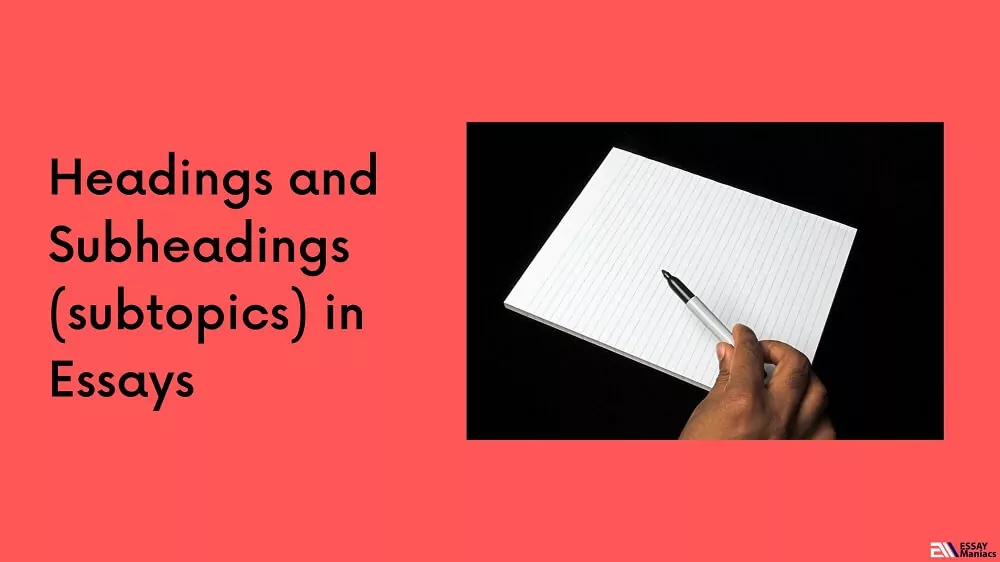
When writing longer essays and research papers (10 pages and above), breaking the test into different but related sections might be helpful to avoid unnecessary strained transition sentences.
The headings are the first thing the readers look at when reading the essay. They are akin to the headlines in a magazine or webpage. Subheadings are the additional subtopics or headings immediately after the main title or header. Headings are meant to grab the readers' attention, but the subheadings make them draw the readers deeper into the topic.
A subheading is a mini-headline given to a section or paragraph within the main text. They are often smaller than the main heading but larger than the paragraph text.
While headings can be used in most academic papers of different lengths (even those less than ten pages), subheadings are reserved for shorter sections within a larger section. If you have a paper with just three main points and the first point has three subpoints, you can use subheadings to organize the subpoints under the main point.
When used in an essay, research paper, or other longer papers, the headings and subheadings should be formatted such that they are distinguishable from the contents of your text.
Let's dig deeper and see how to make headings and subheadings in an essay.
Why Use Headings and Subheadings in Essays and Research Papers
Headings and subheadings capture the readers' attention, making it easier to sell your ideas to those who skim through written pieces first to determine whether it is worth their time.
Using headings and subheadings helps organize your thoughts. They enable readers to focus on the critical aspects of the essay or research paper. In an essay or research paper, each subheading is considered a mini-essay with thoughts limited to a specific element or perspective of the topic.
Using headings and subheadings informs your readers about where they are in the paper. Also, these subheadings act as signposts or directions that orient the readers to your thoughts in the paper.
The subheadings ensure that your thoughts are structured and that you remain focused on the topic within a limited area. For instance, if you are writing a mental health essay or research paper, you can have a subheading dealing with risk factors and another dealing with the impacts of stigma on mental health.
Subheadings also make the research process easier because you can organize your research around them. This way, you can approach your research systematically and limit its scope. You can then scrutinize and organize the scholarly resources rather than focus on the entire research pile.
Having subheadings in essays or research papers makes writing the paper easier. You can plan, draft, and polish each essay section independently. Doing so helps you to write the paper with ease. Consequently, you can fight off writer's block by putting points of argument under each subheading and organizing it later when you are psyched up to write.
Features of a Good Subheading for an Essay or Research Paper
In research writing, it is imperative to have a refined heading and subheading. We discussed how to do this when we wrote about titling an essay and other academic papers. However, certain features make a subheading or a heading stand out. A good subheading can be many things, but let's sample some of the outstanding features it must have. Here are some aspects that make an excellent subheading and heading:
- A good subheading is brief, concise, and focused. Shorter headings and subheadings give meaning and enhance the readability of a research paper or essay.
- It must have a line space between it and the content.
- It contains the keywords that relate to the thesis and topic, telling the reader precisely the main idea of the section's content.
- Its wording matches the rest of the subheadings and headings
- Can create a flow that summarizes the work independently at a glance
- Is ten words or less and refined to have meaning on its own
- It stands out from the rest of the text in terms of styling and formatting
- It engages the readers such that it gives clues about what to expect
- Uses signposting words to realign the interests of the readers
- Are they relevant to the text
- It uses parallel structures for consistency
How to Make Subheadings in An Essay or Paper
If you are like many students who wonder about how to integrate subheadings into an essay, this section clarifies everything. First, however, there are some crucial tips that you need to consider.
Remember, a subheading expands your heading and comes after the latter. While both hook the audience by grabbing their attention, the subheading enables your readers to delve deeper into the topic. Subheadings are used to divide an otherwise large chunk of paper into sections or chapters.
Subheadings are primarily written in sentence cases and should never be in capital letters. Therefore, you should capitalize the first letter of the subheading of your essay. This is unlike the heading in the title case, meaning that all the major words (nouns, adverbs, pronouns, and adjectives) and words with four or more letters have their first words capitalized. Subheadings subordinate the higher levels. To make a good subheading, here are the tips.
1. Choose the correct length
A good essay subheading should be easy to read. Precisely, it should take a few seconds to read. Our experts recommend keeping the subheading between 4 to 10 words, the standard length of subheadings in academic writing. Ensure as well that it fits a single line. If your subheading runs over, it will be ambiguous and might alter the structure of your essay or paper.
2. Limit the information
You only have a few words to impress your readers. Therefore, only bring in the most crucial information you want to use to bait your readers. Avoid examining every aspect and focus on one aspect of the topic. As long as you have aroused the reader's curiosity to explore your essay, that's it!
3. Maintain Consistency
When you use headings and subheadings in an essay or academic paper, ensure that each maintains the same level. You should not skip subheading levels. And if the first subheading is the only subheading, you are better off eliminating it and maintaining the heading. An excellent strategy to maintain this consistency is planning your essay, which you can do by creating an outline .
4. Number appropriately. It is a must
APA or MLA format does not allow you to label headings and subheadings with numbers or letters. However, there are some instances, such as when writing a dissertation or thesis, where you will most likely be required to use multilevel numbering for the headings and subheadings. Therefore, when you number the headings and subheadings, ensure that it is in a consistent format that you can later use when referring to them elsewhere, for instance, in a table of contents. Microsoft Word automates the process of numbering by choosing the heading styles.
5. Be persuasive
A good subheading should coax the readers to read the text. It should give them an appetite to devour your paper. And it should be persuasive because it does the work of signposting the ideas to expect in a subsection.
6. Ensure Progression
When writing the subheadings, ensure they each add new information to your text to avoid repetitive subheadings. It would be wise to ensure that each subheading addresses a unique aspect of the topic instead of echoing the previous subheadings discussed. As you edit your paper, guarantee that the subheadings progress and add new and relevant information to engage the readers.
7. Stay away from puns, contractions, and idioms
Although tempting, avoid using corny words, jokes, and puns in your subheadings. You should not use contractions as well. Introducing these aspects can make your subheadings and headings ambiguous, deterring the readers from reading the content.
8. Ensure they are relevant and engaging
As you write the subheadings, ensure that they are relevant to the content of your essay. Eliminate any irrelevant subheadings in your essay. Think about the vital information you must include and how you need to format it into a separate section. The strategy helps write subheadings that address your essay's real issues. The subheadings should also give the readers a clue of what to expect to grab their attention further.
9. Include Keywords and Phrases
When writing the subheadings, you should include relevant keywords and phrases that attract the readers' attention. In addition, the keywords and phrases should be related to your topic and thesis statement.
10. Format them well
If you are writing an academic paper (research paper or essay), ensure that your subheadings and headings are formatted per the citation and formatting styles. Later in this article, we look at how to format subheadings and headings in MLA and APA, which are the most common styles. You can also acquaint yourself with other academic writing styles such as Chicago, Vancouver, Oxford, Bluebook, or Harvard.
If you intend to write an A essay, consider reading our guide on writing first-class essays to integrate other factors that professors look for when assigning higher grades for essays.
Related Read:
- How to write an introduction .
- Using headings and subheadings in the dissertation literature review.
Headings and Subheadings in APA
In APA formatting and citation style, headings are used in essays and research papers to separate and classify paper sections. The headings are meant to guide the readers through the document. Headings and subheadings are organized in subordination levels, with each section of the paper starting with the highest heading level.
You can organize headings into five different levels in APA. However, it would help if you used the headings in order beginning from level 1, regardless of the number of heading levels.
Below is how to organize the levels:
- Heading 1 is bold, centered, and written in the title case. This can include the main elements of the paper, such as Literature Review , methods, conclusion, discussion, recommendations, etc.
- Heading 2 is flush left, in boldface, and written in title case. These are the headings directly under heading 1. So, for example, under methods (level 1), you can have subsections such as sampling strategy, data analysis, or data processing as level 2.
- Heading 3 is flush left, in boldface italics, and title case.
- Heading 4 is indented, in boldface, and written in title case.
- Heading 5 is indented, in boldface italics, and title case.
You can use at least two subheadings in APA or non at all. If there is just one subheading, the top-level heading is enough, so do away with it.
When writing a paper in APA , the first paragraph is automatically understood as the introduction. Therefore, there is no need to start with the heading "introduction." The paper's title, which is centered and bolded, becomes the de facto level 1 heading. If your introduction has subsections, you can use headings within the introduction beginning with level 2 headings for the first level subsection, level 3 for the subsections of level 2 headings, and so on. After writing the introduction, use the level 1 heading for the following main section of the paper. Headings should be descriptive and concise. They should be well-formatted and clearly worded for visual and content appeal.
Formatting Headings and Subheadings in APA
When writing headings and subheadings in APA, here are a few things to keep in mind:
- The headings in APA are never labeled with numbers or letters
- You should not use more than one subsection within a section
- Ensure that the APA headings and subheadings are descriptive and concise
- Use as many headings and subheadings as you may require
- Headings 3-5 should all be indented and terminated with a period.
- Headings levels 1 and 2 should be formatted in sentence cases.
- Ensure that the first word in the heading level 3-5 is capitalized.
- Begin a paragraph below levels 1 and 2. However, levels 2-5 begin in line with the headings.
- There should be double line spacing for the APA heading.
MLA headings and subheadings enhance a paper's coherence, soundness, and quality. Using the hierarchy of 5 heading levels in APA should be easier now that we have explained everything.
Headings and Subheadings in MLA
MLA headings are sometimes confused with the header. While the MLA heading is found on the first page and serves the purpose of identifying information, the header is the identifier located on top of every document page.
Using section headings in MLA help improve the readability of the document. Students are mainly not required to use headings when writing essays and papers.
Formatting Headings and Subheadings in MLA
- The font should be readable, most preferably Times New Roman or Arial
- Use double-line spacing
- Every new paragraph after the headings or subheadings should have a half an inch indent.
- All the headings and subheadings must be written in the title case
- You should not include a period after the MLA headings and subheadings
- The title is the main heading. It should be center-aligned and written in sentence case. It should never be italicized, bold, underlined, or put into quotation marks unless when referring to works within it.
- All headings that succeed the title of the document are subheadings.
- The subheadings have five different levels, just like in APA formatting.
- The subheadings are styled as per their order of prominence.
Unlike APA, MLA allows the use of font styling to differentiate the levels of the subheadings. However, the styling of the subheadings should be consistent so that the readers can follow the structure of the essay or paper.
Every subheading should appear in the same size, format, and style for easier identification as one reads your text. The subheadings in MLA papers or essays should flush to the left margin to avoid confusing them with block quotes. Avoid online one level for the internal levels. For instance, if you have a level between 1 and 5, you should ensure that there is more than one instance. If you have one level 2 subheading, ensure that you also have a second level 2 subheading. Above all, every heading and subheading must have content or text beneath them. The content should support the thesis statement of your paper.
Related reading:
- Writing case study answers for business and nursing classes .
- Analytical essay writing steps and tips.
Levels of subheadings in MLA formatting
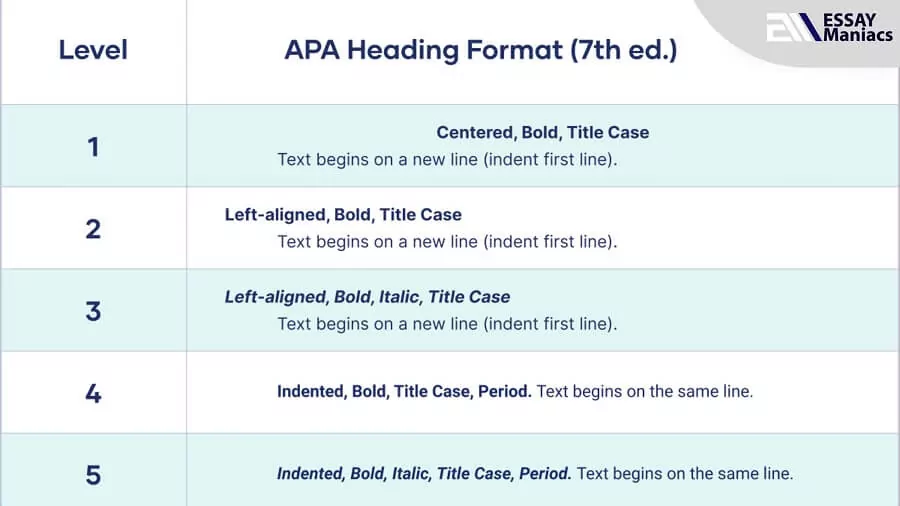
- Level 1 is bold, flush, or aligned with the left margin
- Level 2 is italicized, flush, or aligned with the left margin
- Level 3 is bold and center-aligned
- Level 4 is italicized and center-aligned
- Level 5 is underlined, flush, or aligned with the left margin
Ensure you use the correct subheading level to help you navigate through your essay or paper. It also helps to know what to be added to the automatic table of contents. Use the subheadings as illustrated below:
- Subheading 1 for the first subsection after the chapter title
- Subheading 2 for the subsections that are directly under Subheading 1
- Subheading 3 for the subsections that are directly under Subheading 2
- Subheading 4 for the subsections that are directly under Subheading 3
- Subheading 5 for the subsections that are directly under Subheading 4
Take some time and watch this video by Dr. Andy Jonson illustrates how to use headings and subheadings in academic writing.
Below are some sample questions, expert answers, and recommendations for essay subheadings and headings.
Should essays have subheadings?
Although shorter essays are written in continuous, flowing, and paragraphed texts and do not need subheadings, longer essays are carefully structured using headings and subheadings.
An essay or research paper can have headings and subheadings (subtopics) if it is long enough to accommodate different sections. Nevertheless, when writing the headings and subheadings, they should be relevant and consistent with the topic and contribute to the overarching goal of the essay or research paper (the thesis statement). A good length for a heading or subheading should be ten words or less. While standard essays do not use subheadings, they assuredly improve the structure of extended essays.
Subheadings subordinate the headings (the title of the essay). They should be persuasive, descriptive, and conversational. They should elaborate on what is in the headline and capture the importance of the topic. Maintain consistency when writing them.
Can introductions have subheadings?
For short papers, no. However, you can include sub-sections for longer papers with appropriate headings and subheadings. For instance, when writing a proposal, dissertation, or thesis, you can have sections and subsections for the problem statement, background information, research questions, hypothesis, aims/objectives, and paper overview.
Can a conclusion have a subheading?
You should not include subheadings in the concluding paragraphs of an essay unless for more extended research papers.
Can subheadings in essays be questions?
No, section headings and subheadings must not be phrased as questions in MLA, APA, or Harvard formatting styles.
Need a Discount to Order?
15% off first order, what you get from us.

Plagiarism-free papers
Our papers are 100% original and unique to pass online plagiarism checkers.

Well-researched academic papers
Even when we say essays for sale, they meet academic writing conventions.

24/7 online support
Hit us up on live chat or Messenger for continuous help with your essays.

Easy communication with writers
Order essays and begin communicating with your writer directly and anonymously.
How do I style headings and subheadings in a research paper?
Headings and subheadings can help organize and structure your writing. In general, longer and more complex works warrant more of them than shorter ones. Avoid overusing headings in short projects; they should never be used to compensate for poor structure or to explain an underdeveloped idea.
When headings are called for in your writing project, observe the basic guidelines below.
The paper or chapter title is the first level of heading, and it must be the most prominent.
Headings should be styled in descending order of prominence. After the first level, the other headings are subheadings—that is, they are subordinate. Font styling and size are used to signal prominence. In general, a boldface, larger font indicates prominence; a smaller font, italics, and lack of bold can be used to signal subordination. For readability, don’t go overboard: avoid using all capital letters for headings (in some cases, small capitals may be acceptable):
Heading Level 1
Heading Level 2
Heading Level 3
Note that word-processing software often has built-in heading styles.
Consistency
Consistency in the styling of headings and subheadings is key to signaling to readers the structure of a research project. That is, each level 1 heading should appear in the same style and size, as should each level 2 heading, and so on. Generally avoid numbers and letters to designate heads unless you are working in a discipline where doing so is conventional. Note that a heading labeled “1” requires a subsequent heading labeled “2,” and a heading labeled “a” requires a subsequent heading labeled “b.”
In a project that is not professionally designed and published, headings should be flush with the left margin, to avoid confusion with block quotations. (The exception is the paper or chapter title, which is centered in MLA style.)
For readability, it is helpful to include a line space above and below a heading, as shown in this post.
No internal heading level should have only one instance. For example, if you have one level 1 heading, you need to have a second level 1 heading. (The exceptions are the paper or chapter title and the headings for notes and the list of works cited.) You should also generally have text under each heading.
Capitalization
Capitalize headings like the titles of works, as explained in section 1.5 of the MLA Handbook .
The shorter, the better.
Have a language expert improve your writing
Run a free plagiarism check in 10 minutes, generate accurate citations for free.
- Knowledge Base
- Academic writing
- How to write effective headings
How to Write and Format Headings in Academic Writing
Published on March 15, 2019 by Shane Bryson . Revised on July 23, 2023.
The goal of using headings in a document is not only to divide information, but also to allow easy navigation of the document. In academic writing , headings help readers find the specific information they want while retaining a sense of how that information fits with everything else in the document.
To test for overall heading clarity, ask yourself the following: from reading your headings in sequence, would an informed reader understand…
- The content of the document as a whole?
- The specific content of each section?
- How each section fits with the others?
If not, your headings aren’t effective , and may need some improvement.
Instantly correct all language mistakes in your text
Upload your document to correct all your mistakes in minutes

Table of contents
Headings vs. titles, how long should headings be, using descriptive headings, technical terms in headings, capitalization, formatting and sequencing, other interesting articles.
Although heading and titles are similar, they are distinct: A title leads the entire document and captures its content in one or two phrases; a heading leads only a chapter or section and captures only the content of that chapter or section. Read more in our article on writing good titles in academic writing .
Here's why students love Scribbr's proofreading services
Discover proofreading & editing
Headings should be as long as it takes to clearly communicate the content of the sections they head. However, each heading should be as concise as possible – a good rule of thumb is to limit the heading length to one line.
Higher-level vs. lower-level headings
Higher-level headings often make do with a single word (e.g. “ Introduction ” or “ Methods ”), while lower-level headings are often longer. This is because higher-level headings cover more general content and provide an overview. One word is clear enough because everyone already knows what happens in an introduction chapter – nothing more needs to be said.
Lower-level headings should use more specific terminology to help clarify the content of the section. These headings help readers find the exact information they’re looking for.
The main goal of a heading is to inform the reader of what content they can find in that section, so make your headings as descriptive as possible. The examples below show one non-descriptive heading and three descriptive headings that provide the reader with much more information.
- Profile of GPS technology
- Function of GPS in aviation
- GPS before 1999
Avoiding repetitive headings
No two sections should focus on the exact same content, so no two headings should be identical. Instead of closing a chapter with “Summary,” for example, try making the heading little more descriptive: “Summary of X .”
Documents in fields that rely heavily on jargon and technical language will contain headings that might not be clear to every reader. That’s fine as long as you keep your reader’s knowledge level in mind. However, if you don’t need the jargon to give a specific idea of your content, then avoid it.
Check for common mistakes
Use the best grammar checker available to check for common mistakes in your text.
Fix mistakes for free
At the outset, make a plan for how you will deal with matters of capitalization , formatting and sequencing of headings. Headings at the same level should be formatted the same. For instance, “Section 2.2” should get the same treatment as “Section 4.1”. They should also have parallel structure .
Often, your style guide or university will offer specific directions on how to approach the capitalization, formatting, and sequencing of headings, so it’s wise to check before you start writing them. For example, APA headings and MLA headings require specific formatting.
Using automatic heading styles in Word
To avoid having to format each heading separately, it’s smart to use the heading styles feature offered by Microsoft Word, Google Docs and many other word-processing softwares.
An extra benefit of using these heading styles is that you can automatically generate and update a table of contents. This will save you a lot of time later on. Read more about this in our article on creating a table of contents .
If you want to know more about AI for academic writing, AI tools, or fallacies make sure to check out some of our other articles with explanations and examples or go directly to our tools!
- Ad hominem fallacy
- Post hoc fallacy
- Appeal to authority fallacy
- False cause fallacy
- Sunk cost fallacy
- Deep learning
- Generative AI
- Machine learning
- Reinforcement learning
- Supervised vs. unsupervised learning
(AI) Tools
- Grammar Checker
- Paraphrasing Tool
- Text Summarizer
- AI Detector
- Plagiarism Checker
- Citation Generator
Cite this Scribbr article
If you want to cite this source, you can copy and paste the citation or click the “Cite this Scribbr article” button to automatically add the citation to our free Citation Generator.
Bryson, S. (2023, July 23). How to Write and Format Headings in Academic Writing. Scribbr. Retrieved April 1, 2024, from https://www.scribbr.com/academic-writing/effective-headings/

Is this article helpful?
Shane Bryson
Shane finished his master's degree in English literature in 2013 and has been working as a writing tutor and editor since 2009. He began proofreading and editing essays with Scribbr in early summer, 2014.
Other students also liked
Capitalization in titles and headings, apa headings and subheadings, forging good titles in academic writing, unlimited academic ai-proofreading.
✔ Document error-free in 5minutes ✔ Unlimited document corrections ✔ Specialized in correcting academic texts
- Affiliate Program

- UNITED STATES
- 台灣 (TAIWAN)
- TÜRKIYE (TURKEY)
- Academic Editing Services
- - Research Paper
- - Journal Manuscript
- - Dissertation
- - College & University Assignments
- Admissions Editing Services
- - Application Essay
- - Personal Statement
- - Recommendation Letter
- - Cover Letter
- - CV/Resume
- Business Editing Services
- - Business Documents
- - Report & Brochure
- - Website & Blog
- Writer Editing Services
- - Script & Screenplay
- Our Editors
- Client Reviews
- Editing & Proofreading Prices
- Wordvice Points
- Partner Discount
- Plagiarism Checker
- APA Citation Generator
- MLA Citation Generator
- Chicago Citation Generator
- Vancouver Citation Generator
- - APA Style
- - MLA Style
- - Chicago Style
- - Vancouver Style
- Writing & Editing Guide
- Academic Resources
- Admissions Resources
Formatting Research Paper Headings and Subheadings
Different style guides have different rules regarding the formatting of headings and subheadings in a paper, but what information you should actually put into your subheadings is a different question and often up to personal taste. Here we quickly summarize general guidelines, different approaches, and what not to do when choosing headings for a research paper.
Does it matter how I name my sections and subsections?
The main sections of a research paper have general headers and are often journal-specific, but some (e.g., the methods and discussion section) can really benefit from subsections with clear and informative headers. The things to keep in mind are thus the general style your paper is supposed to follow (e.g., APA, MLA), the specific guidelines the journal you want to submit to lists in their author instructions , and your personal style (e.g., how much information you want the reader to get from just reading your subsection headers).
Table of Contents:
- Style Guides: Rules on Headings and Subheadings
- What Sections and Subsections Do You Need?
- How Should You Name Your Sections and Subsections?
- Avoid These Common Mistakes

Style Guides: Research Paper Heading and Subheading Format
Headers identify the content within the different sections of your paper and should be as descriptive and concise as possible. That is why the main sections of research articles always have the same or very similar headers ( Introduction, Methods, Results, Discussion ), with no or only small differences between journals. However, you also need to divide the content of some of these sections (e.g., the method section) into smaller subsections (e.g., Participants, Experimental Design, and Statistical Analysis ), and make sure you follow specific journal formatting styles when doing so.
If the journal you submit to follows APA style , for example, you are allowed to use up to five levels of headings, depending on the length of your paper, the complexity of your work, and your personal preference. To clearly indicate how each subsection fits into the rest of the text, every header level has a different format – but note that headers are usually not numbered because the different formatting already reflects the text hierarchy.
APA style headings example structure
Level 1 Centered, Bold, Title Case
Text begins as a new paragraph.
Level 2 Left-aligned, Bold, Title Case
Level 3 Left-aligned, Bold Italic, Title Case
Level 4 Indented, Bold, Title Case, Period . Text begins on the same
line and continues as a regular paragraph.
Level 5 Indented, Bold Italic, Title Case, Period. Text begins on the
same line and continues as a regular paragraph.
If you only need one section header (e.g. Methods ) and one level of subsection headers (e.g., Participants, Experimental Design, and Statistical Analysis ), use Level 1 and Level 2 headers. If you need three levels of headings, use Levels 1, 2, and 3 (and so on). Do not skip levels or combine them in a different way.
If you write a paper in Chicago style or MLA style , then you don’t need to follow such exact rules for headings and subheadings. Your structure just has to be consistent with the general formatting guidelines of both styles (12-pts Times New Roman font, double-spaced text, 0.5-inch indentation for every new paragraph) and consistent throughout your paper. Make sure the different formatting levels indicate a hierarchy (e.g., boldface for level 1 and italics for level 2, or a larger font size for level 1 and smaller font size for level 2). The main specifics regarding Chicago and MLA headings and subheadings are that they should be written in title case (major words capitalized, most minor words lowercase) and not end in a period. Both styles allow you, however, to number your sections and subsections, for example with an Arabic number and a period, followed by a space and then the section name.
MLA paper headings example structure
1. Introduction
2. Material and Methods
2.1 Subject Recruitment
2.2 Experimental Procedure
2.3 Statistical Analysis
3.1 Experiment 1
3.2 Experiment 2
4. Discussion
5. Conclusion
What research paper headings do you need?
Your paper obviously needs to contain the main sections ( Introduction, Methods, Results, Discussion, and maybe Conclusion ) and you need to make sure that you name them according to the target journal style (have a look at the author guidelines if you are unsure what the journal style is). The differences between journals are subtle, but some want you to combine the results and discussion sections, for example, while others don’t want you to have a separate conclusion section. You also need to check whether the target journal has specific rules on subsections (or no subsections) within these main sections. The introduction section should usually not be subdivided (but some journals do not mind), while the method section, for example, always needs to have clear subsections.
How to Name Your Sections and Subsections
The method section subheadings should be short and descriptive, but how you subdivide this section depends on the structure you choose to present your work – which can be chronological (e.g., Experiment 1, Experiment 2 ) or follow your main topics (e.g., Visual Experiment, Behavioral Experiment, Questionnaire ). Have a look at this article on how to write the methods for a research paper if you need input on what the best structure for your work is. The method subheadings should only be keywords that tell the reader what information is following, not summaries or conclusions. That means that “ Subject Recruitment ” is a good methods section subheading, but “ Subjects Were Screened Using Questionnaires ” is not.
The subheadings for the result section should then follow the general structure of your method section, but here you can choose what information you want to put in every subheading. Some authors keep it simple and just subdivide their result section into experiments or measures like the method section, but others use the headings to summarize their findings so that the reader is prepared for the details that follow. You could, for example, simply name your subsections “ Anxiety Levels ” and “ Social Behavior ,” if those are the measures you studied and explained in the method section.
Or, you could provide the reader with a glimpse into the results of the analyses you are going to describe, and instead name these subsections “ Anxiety-Like Behaviors in Mutant Mice ” and “ Normal Social Behaviors in Mutant Mice .” While keeping headings short and simple is always a good idea, such mini-summaries can make your result section much clearer and easier to follow. Just make sure that the target journal you want to submit to does not have a rule against that.
Common Heading and Subheading Mistakes
Subheadings are not sentences.
If your heading reads like a full sentence, then you can most probably omit the verb or generally rephrase to shorten it. That also means a heading should not contain punctuation except maybe colons or question marks – definitely don’t put a period at the end, except when you have reached heading level 4 in the APA formatting style (see above) and the rules say so.
Be consistent
Always check your numbering, for example for spaces and periods before and after numbers (e.g., 3.2. vs 3.2 ), because readability depends on such features. But also make sure that your headings are consistent in structure and content: Switching between short keyword headings (e.g., “ Experiment 2 ”) and summary headings (e.g., “ Mice Do not Recognize People ”) is confusing and never a good idea. Ideally, subheadings within a section all have a similar structure. If your first subsection is called “ Mice Do not Recognize People ,” then “ People Do not Recognize Mice” is a better subheader for the next subsection than “Do People Recognize Mice? ”, because consistency is more important in a research paper than creativity.
Don’t overdo it
Not every paragraph or every argument needs a subheading. Only use subheadings within a bigger section if you have more than one point to make per heading level, and if subdividing the section really makes the structure clearer overall.
Before submitting your journal manuscript to academic publishers, be sure to get English editing services , including manuscript editing or paper editing from a trusted source. And receive instant proofreading with Wordvice AI, our AI online text editor , which provides unlimited editing while drafting your research work.
Purdue Online Writing Lab Purdue OWL® College of Liberal Arts
APA Headings and Seriation

Welcome to the Purdue OWL
This page is brought to you by the OWL at Purdue University. When printing this page, you must include the entire legal notice.
Copyright ©1995-2018 by The Writing Lab & The OWL at Purdue and Purdue University. All rights reserved. This material may not be published, reproduced, broadcast, rewritten, or redistributed without permission. Use of this site constitutes acceptance of our terms and conditions of fair use.
Note: This page reflects the latest version of the APA Publication Manual (i.e., APA 7), which released in October 2019. The equivalent resource for the older APA 6 style can be found here .
APA Style uses a unique headings system to separate and classify paper sections. Headings are used to help guide the reader through a document. The levels are organized by levels of subordination, and each section of the paper should start with the highest level of heading. There are 5 heading levels in APA. Regardless of the number of levels, always use the headings in order, beginning with level 1. The format of each level is illustrated below:
Thus, if the article has four sections, some of which have subsections and some of which don’t, use headings depending on the level of subordination. Section headings receive level one format. Subsections receive level two format. Subsections of subsections receive level three format. For example:
Method (Level 1)
Site of Study (Level 2)
Participant Population (Level 2)
Teachers (Level 3)
Students (Level 3)
Results (Level 1)
Spatial Ability (Level 2)
Test One (Level 3)
Teachers With Experience. (Level 4)
Teachers in Training. (Level 4)
Teaching Assistants . (Level 5)
Test Two (Level 3)
Kinesthetic Ability (Level 2)
In APA Style, the Introduction section never gets a heading and headings are not indicated by letters or numbers. For subsections in the beginning of a paper (introduction section), the first level of subsection will use Level 2 headings — the title of the paper counts as the Level 1 heading. Levels of headings will depend upon the length and organization of your paper. Regardless, always begin with level one headings and proceed to level two, etc.
Special headings called section labels are used for certain sections of a paper which always start on a new page.
- Paper title
- Appendix A (and so on for subsequent appendices)
These labels should be positioned on their own line at the top of the page where the section starts, in bold and centered.
APA also allows for seriation in the body text to help authors organize and present key ideas. For lists where a specific order or numbered procedure is necessary, use an Arabic numeral directly followed by a period, such as:
On the basis of four generations of usability testing on the Purdue OWL, the Purdue OWL Usability Team recommended the following:
- Move the navigation bar from the right to the left side of the OWL pages.
- Integrate branded graphics (the Writing Lab and OWL logos) into the text on the OWL homepage.
- Add a search box to every page of the OWL.
- Develop an OWL site map.
- Develop a three-tiered navigation system.
Numbered lists should contain full sentences or paragraphs rather than phrases. The first word after each number should be capitalized, as well as the first word in any following sentence; each sentence should end with a period or other punctuation.
For lists that do not communicate hierarchical order or chronology, use bullets:
In general, participants found the user-centered OWL mock up to be easier to use. What follows are samples of participants' responses:
- "This version is easier to use."
- "Version two seems better organized."
- "It took me a few minutes to learn how to use this version, but after that, I felt more comfortable with it."
Authors may also use seriation for paragraph length text.
For seriation within sentences, authors may use letters:
On the basis of research conducted by the usability team, OWL staff have completed (a) the OWL site map; (b) integrating graphics with text on the OWL homepage; (c) search boxes on all OWL pages except the orange OWL resources (that is pending; we do have a search page); (d) moving the navigation bar to the left side of pages on all OWL resources except in the orange area (that is pending); (e) piloting the first phase of the three-tiered navigation system, as illustrated in the new Engagement section.
Authors may also separate points with bullet lists:
On the basis of the research conducted by the usability team, OWL staff have completed
- the OWL site map;
- integrating graphics with text on the OWL homepage;
- search boxes on all OWL pages except the orange OWL resources (that is pending; we do have a search page);
- moving the navigation bar to the left side of pages on all OWL resources except in the orange area (that is pending);
- piloting the first phase of the three-tiered navigation system, as illustrated in the new Engagement section.
If your bulleted list is part of the sentence and is not preceded by a colon, treat the bullets like a part of the sentence, adhering to standard capitalization and punctuation. This option is helpful for complex or longer bulleted sentences that may be more difficult to read without the aid of punctuation. For items in a bulleted list that are phrases rather than sentences, no punctuation is necessary.
Essay writing: Formatting
- Introductions
- Conclusions
- Analysing questions
- Planning & drafting
- Revising & editing
- Proofreading
- Essay writing videos
Jump to content on this page:
Essays are formal documents and should look professional Advice from the Skills Team
Whilst there are no hard rules about how you format essays, there are some conventions and common practices that are best to follow. If you use the settings on this page, you will produce an acceptably formatted essay.
Document layout

Margins - between 2 cm and 2.54 cm (1 inch) all around.
Line spacing - either 1.5 or double-line spacing.
Paragraph spacing - either 1 clear line between or at least 8 pt space after each paragraph (more if double-line spaced)
Alignment - left aligned (fully justified with a straight right-edge is not recommended as this reduces readability and accessibility). Some longer essays may require subheadings which should also be left-aligned.
Indents - no indents on first lines of paragraphs are needed.
It is also good practice to put your student number and module number in the header of the document and a page number at the bottom of the page.
Text formatting
Font - the default font that comes with MS Word (currently Calibri) is fine for academic work. You may see persistent advice in handbooks that suggests you should use Times New Roman or Arial. If you prefer these, you can change it - but this is no longer a requirement.
Font size - fonts should be 11 or 12 point.
Font style - headings and subheadings, if they are required (most essays will not use them), are usually formatted in bold and should be at least 2 point sizes larger than the standard text. Underlining should be avoided as this is seen as rather dated. Some text can be formatted in italics - see our page Italics, when to use them , for guidance.
Shorter quotations in the text do not need to be italicised and should have double-quotations marks "like this" to indicate they are direct quotations. Longer quotations (what counts as this differs depending on your referencing style) should be created in their own paragraph, single spaced and indented by 1cm from both left and right margins:
For example:
Graduate attributes for employability are described as:
a set of achievements – skills, understandings and personal attributes – that makes graduates more likely to gain employment and be successful in their chosen occupations, which benefits themselves, the workforce, the community and the economy. (Yorke, 2006)
The main change in this definition compared to the earlier definition of graduate attributes from Bowden (2000) is that that the attributes are no longer ...
UoH Harvard/APA
Your reference list should be in alphabetical order (by author surname) and single line spaced. There should be a clear line space (or at least 6 pt space) between each reference. All references should be left-aligned with no indentation. For information about how to format individual references, see the Harvard Hull Referencing Guide.
UoH Footnotes
Your reference list should be in alphabetical order (by first author surname) and single line spaced. All references should be left-aligned and have a hanging indent (all but the first line are indented by approx. 1cm). For information about how to format individual references, see the Footnotes Hull Referencing Guide.
Other referencing styles
Please see your individual departmental guidance.
We provide here a Microsoft Word template that can be used for your essays. It has the correct layout and formatting, including useful styles.
- Essay template
Download this template to somewhere you can access easily. When you click to open it, it will open a new document based on the template , leaving the original intact.
- << Previous: Conclusions
- Next: Analysing questions >>
- Last Updated: Nov 3, 2023 3:17 PM
- URL: https://libguides.hull.ac.uk/essays
- Login to LibApps
- Library websites Privacy Policy
- University of Hull privacy policy & cookies
- Website terms and conditions
- Accessibility
- Report a problem
- Have your assignments done by seasoned writers. 24/7
- Contact us:
- +1 (213) 221-0069
- [email protected]

Can an Essay Have Subheadings, subtitles or subtopics?
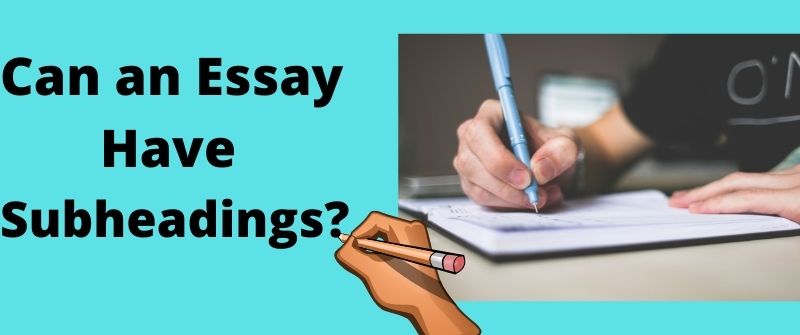
Subheadings in an essay
Subheadings happen to be among the essential sections of an essay. The subheading helps to capture the reader’s attention. Furthermore, the subheading makes the essay to stay more attractive and interesting.
The subheading restores the reader’s focus on the critical components of the essay as it makes the essay appear more structured. The subheading will be giving a clue of what to expect in the content.
An essay can have subheadings or subtopics if it is long enough to accommodate many parts with subtopics in each part.

However, the subtopics and subtitles must be consistent with the overall topic by contributing to prove the thesis of the essay. If necessary, the best practice is to limit essay subheadings to 10 words.
While they are not recommended for standard essays, subheadings can help improve the structure of a long essay. They frame the topic of your content.
Different subheadings exist, which you will include in your essay as a way of indicating their relative importance. Ensure that such subheadings are easy to see at the initial look. Furthermore, they offer minor details, which are great at supporting the key idea in the essay.
No, but you can only use them when instructed by the teacher. If you are not using them, ensure that your content makes sense and lacks grammatical mistakes. Also, ensure that your paragraphs are short and precise to the point to catch the attention of the reader.
Need Help with your Homework or Essays?
Tips on how to incorporate subheadings in an essay.
The subheading is a text under the heading that expands on what is on the heading. The same subheading should have the power to hook the audience into reading your piece. They assist the author in saying something which one cannot say in a single headline.

Authors use the subheadings to make divisions of various chapters.
Notably, the subheading should not be in capital letters.
However, you should capitalize the first letter of the subheading.
The subheading should perform a subordinate to the higher levels. You can make an irresistible subheading by performing the following actions.
1. Select the Correct Length
The correct subheading should take the reader a few seconds to read through. The correct standard should have between 4 to 10 words. The proper practice should ensure that you do not go beyond the length of the headline.
2. Correct Amount of Information
You should stick to the most critical information that the reader requires to know. You should avoid explaining everything. You should just provide enough details and leave the curiosity to cause them to continue exploring your essay.
3. Be Persuasive Enough
One should include the correct amount of persuasion. The best practice is to use the subheadings for the intended purpose. In other words, it should coerce the reader to convert.
4. Place the Heading well
The free-standing subheading should end the page; there should be an allowance for the heading space preceding it.
Alternatively, you should move the subheading to the top of the preceding page. That is the incidence where we allow a gap in the text if it is not the end of the chapter.
5. Number your Heading if Needed
One can opt to number the subheading using a standard numbering system. You can use Arabic numerals and keep the sequence and the flow of your article logical.
First, it is correct to begin with the most vital points and make the less relevant ones at the bottom.
6. Be Consistent with the Paragraphs
Ensure that every subheading level appears in the same form. For example, let the subheadings be in the same order without skipping one. In this case, the first subheading will follow the same order if preceding to toe and three and not vice versa.
The author should determine the number of subheadings to place in an article. Establish that they all follow the pattern of the sub-heading.
More on this, read our guide to writing good essays so that you can learn more about the same and become a better essay writer.
Check out the guide on whether an essay can have bullet points to look at another angle of writing essays.
Get a Brilliant Essay today!
Let our essay writing experts help you get that A in your next essay. Place your order today, and you will enjoy the benefits.
Frequently Asked Questions
How do you use headings and subheadings in an essay.
The headline is an integral part of an essay because it is the first thing the reader sees before reading the piece. The headline should grab the reader’s attention to encourage them to continue reading the content.
Besides, we amplify the information in the title by backing them with the subheadings. These subheadings will make the title more relevant by giving minute details about the topic. It is a standard way of organizing your content for the reader to understand your points clearly.
What words should not be used in an essay?
You should avoid using abbreviations such as won’t, don’t, or can’t. Furthermore, the use of idiom is a no-go -zone. Last but not least, avoid rhetorical questions.

Josh Jasen or JJ as we fondly call him, is a senior academic editor at Grade Bees in charge of the writing department. When not managing complex essays and academic writing tasks, Josh is busy advising students on how to pass assignments. In his spare time, he loves playing football or walking with his dog around the park.
Related posts

Overcoming the feeling and fear of writing essays
Overcoming the Feeling and Fear of Writing Essays

Spaces between Paragraphs in an Essay
How Many Spaces between Paragraphs in an Essay

Double Space an Essay
Should You Double Space an Essay: When and When Not To

What is a Subheading? A Clear Definition and Examples
- February 23, 2024
- Content Marketing

Table of Contents
What is a subheading? A subheading is a secondary title that divides content into sections, making it easier to read and navigate.
Subheadings are an essential part of any written content, whether it’s a research paper, a news article, or a blog post. They are used to break up the text into smaller, more manageable sections, making it easier for the reader to follow along and understand the content. A subheading is a secondary heading that appears below the main heading, and it provides additional information about the topic being discussed.

Understanding what is a subheading, is crucial for anyone who writes or reads content online. They help to organize information and make it more accessible to the reader. Subheadings also play a critical role in search engine optimization (SEO) by providing search engines with additional information about the content on the page. This can help to improve the page’s ranking in search results, making it more visible to potential readers.
Creating effective subheadings requires careful thought and consideration. The subheading should be relevant to the content that follows, and it should provide a clear and concise summary of what the reader can expect to learn. Additionally, the subheading should be formatted in a way that is easy to read and visually appealing. By following these guidelines, writers can create subheadings that enhance the overall structure and readability of their content.
Key Takeaways
- Subheadings are secondary headings that appear below the main heading and provide additional information about the topic being discussed.
- Subheadings are essential for organizing information and making it more accessible to readers, as well as improving search engine optimization.
- Effective subheadings should be relevant, clear, concise, and visually appealing.
What is a Subheading
Definition and Purpose
Subheadings are secondary headings that are used to break down a piece of content into smaller, more manageable sections. They are typically found below the main heading and are used to provide additional information about the content that follows. Subheadings are also used to help guide the reader through the content and to make it easier to navigate.
The purpose of subheadings is to provide structure and hierarchy to the content. They help to organize the information and make it more digestible for the reader. Subheadings can also be used to highlight key points or to introduce new topics within the content.
Importance in Text Hierarchy
Subheadings play an important role in the hierarchy of a piece of content. They help to break up the text and make it easier to read, which can improve the overall user experience. Subheadings also help to establish the main points of the content and to provide a roadmap for the reader.
In terms of hierarchy, subheadings are typically used to support the main heading and to provide additional context for the content. They are usually formatted differently from the main heading, such as being smaller in size or using a different font. This helps to differentiate the subheading from the main heading and to make it clear that it is a secondary heading.
According to Grammarly , subheadings can also improve the SEO of a piece of content by making it easier for search engines to understand the structure of the content. This can lead to higher rankings in search results and increased visibility for the content.
Overall, subheadings are an important tool for writers and content creators. They help to organize the content and make it more accessible for the reader, while also improving the overall quality of the content.
Creating Effective Subheadings
Subheadings are a crucial element of any well-structured article. They serve as a roadmap that guides the reader through the content and helps break up large blocks of text into smaller, more manageable sections. In this section, we will explore the characteristics of good subheadings and provide tips for writing effective ones.
Characteristics of Good Subheadings
Good subheadings have several key characteristics that set them apart from ineffective ones. First and foremost, they should be clear and concise. A subheading that is too long or convoluted can confuse the reader and detract from the overall readability of the article. Additionally, subheadings should be written in title case and should accurately reflect the content that follows.
Another important characteristic of good subheadings is that they should be unique. Each subheading should provide information that is distinct from the other headings in the article. This helps keep the content organized and makes it easier for the reader to follow along.
Consistency is also essential when it comes to subheadings. All headings should be written in the same format, and the same style should be used throughout the article. This helps create a sense of cohesion and makes the content more visually appealing.
Tips for Writing Subheadings
Writing effective subheadings can be challenging, but there are several tips that can help. First and foremost, it’s important to create a list of the main points that will be covered in the article. This will help guide the creation of subheadings that accurately reflect the content that follows.
Another useful tip is to use a formula when creating subheadings. For example, a common formula is to use a mini-headline that includes a keyword or phrase that summarizes the content that follows. This helps make the subheading more compelling and useful to the reader.
Context is also important when it comes to subheadings. Each subheading should provide enough context to help the reader understand what will be covered in the following section. This can be achieved by using descriptive language and including relevant information.
Finally, it’s important to inject some personality into subheadings. While they should be clear and concise, they can also be creative and engaging. This helps capture the reader’s attention and makes the content more enjoyable to read.
For more information on creating effective subheadings, check out this resource , which provides additional tips and examples.
Formatting and Style
Subheadings are an essential part of any well-written document, and formatting and style are crucial to their effectiveness. Proper use of font and text features, consistency in formatting, and the use of keywords and phrases are all important considerations when creating subheadings.
Font and Text Features
Font and text features can be used to make subheadings stand out and draw attention to important information. Bold and italicized text, different font sizes and styles, and colored text are all options for creating visually appealing subheadings. However, it is important to use these features sparingly and consistently to avoid overwhelming the reader.
Consistency in Formatting
Consistency in formatting is crucial when creating subheadings. Using the same font, text features, and heading levels throughout the document helps to create a cohesive and professional appearance. This consistency also makes it easier for the reader to navigate the document and find important information.
Using Keywords and Phrases
Using keywords and phrases in subheadings is an effective way to improve search engine optimization (SEO) and make the document easier to find online. Including relevant keywords in subheadings can help search engines understand the content of the document and rank it higher in search results. However, it is important to use keywords and phrases naturally and avoid overusing them.
When creating subheadings, it is important to follow proper formatting guidelines. The American Psychological Association (APA) has specific guidelines for formatting headings, including the use of parallel structure and specific heading levels. Following these guidelines can help to create a professional and well-organized document.
Overall, subheadings are an important part of any document, and proper formatting and style can make them more effective. By using font and text features, maintaining consistency in formatting, and including relevant keywords and phrases, subheadings can improve the readability and SEO of a document.
For more information on creating effective subheadings, check out this resource .
Subheadings in Digital Content

Subheadings are an essential part of digital content , used to break up text and make it easier to read. They are usually formatted as H2 or H3 headings in HTML and can help improve the readability and organization of a blog post or website.
SEO and Subheadings
Subheadings also play an important role in search engine optimization (SEO). Search engines like Google use algorithms to analyze website content and determine its relevance to specific search queries. By using subheadings, website owners can make it easier for search engines to understand the structure and content of their site, which can help boost their SEO.
According to Moz , a leading authority on SEO, using subheadings can also help improve the user experience of a website. By breaking up text into smaller, more manageable chunks, subheadings can make it easier for visitors to find the information they are looking for and navigate a site more efficiently.
Navigation and User Experience
In addition to boosting SEO, subheadings can also have a positive impact on website navigation and user experience. By using descriptive and informative subheadings, website owners can help visitors quickly find the information they need and understand the structure of a page or blog post.
WordPress, a popular content management system, makes it easy to add subheadings to blog posts and pages. Users can simply highlight the text they want to turn into a subheading and select the appropriate heading style from the drop-down menu.
Overall, subheadings are an important tool for optimizing digital content for both search engines and human visitors. By using descriptive and informative subheadings, website owners can improve the readability, organization, and overall effectiveness of their content.
Incorporating Additional Elements

Subheadings are an essential tool for organizing and breaking up large blocks of text. However, incorporating additional elements such as images, links, and calls to action can enhance the effectiveness of subheadings even further.
Images and Visual Aids
Including images and other visual aids can make subheadings more engaging and help to break up large blocks of text. Images can also be used to illustrate key points and concepts, making them easier to understand. For example, a subheading about the benefits of exercise could be accompanied by an image of someone jogging or lifting weights.
Links and Calls to Action
Links and calls to action (CTAs) can also be incorporated into subheadings to encourage readers to take action or explore further. For example, a subheading about a new product could include a CTA to “Learn More” or “Buy Now.” Additionally, including links to external resources with high authority on the topic can add credibility to the information presented.
When incorporating additional elements into subheadings, it is important to ensure they are relevant and enhance the overall message. Overuse of these elements can be distracting and reduce the effectiveness of the subheading. By carefully selecting and incorporating these elements, subheadings can become even more powerful tools for organizing and presenting information.
Examples and Best Practices

Analyzing Effective Subheadings
Subheadings are an essential part of any well-structured content. They provide context, break up large blocks of text, and help readers navigate through the content more efficiently. Effective subheadings can significantly improve the reading experience and make the content more accessible to a broader audience.
One of the best practices for creating effective subheadings is to make them descriptive and informative. A subheading should be a brief summary of the content that follows and should give the reader an idea of what to expect in the upcoming section. It should also be relevant to the main headline and the overall context of the article.
Another important aspect of creating effective subheadings is to use formatting to make them stand out. Bold, italic, or underlined text can make the subheading more noticeable and help it catch the reader’s eye. However, it’s essential to use formatting sparingly and consistently throughout the article to avoid confusing the reader.
Common Mistakes to Avoid
While subheadings can be a powerful tool for improving the reading experience, there are some common mistakes that writers should avoid. One of the most significant mistakes is using subheadings that are too vague or generic. A subheading should provide specific information about the content that follows and not just restate the main headline.
Another mistake is using subheadings that are too long or complicated. Subheadings should be short and to the point, and they should not require the reader to spend too much time deciphering their meaning. It’s also essential to avoid using subheadings that are too similar to each other, as this can make the content feel repetitive and tedious to read.
In summary, effective subheadings are an essential part of any well-structured content. They provide context, break up large blocks of text, and help readers navigate through the content more efficiently. By following best practices and avoiding common mistakes, writers can create subheadings that improve the reading experience and make the content more accessible to a broader audience.
For more information on subheadings and their benefits, check out this guide from Grammarly, a reputable source on writing and grammar.
Frequently Asked Questions

How do you effectively use subheadings in writing?
Subheadings are useful tools for breaking up long pieces of text into smaller, more manageable sections. To use subheadings effectively, it is important to ensure that they accurately reflect the content of the section they precede. Additionally, subheadings should be concise and to the point, and should be formatted consistently throughout the document.
What distinguishes a heading from a subheading?
Headings and subheadings serve similar purposes in organizing written content, but they differ in their level of specificity. Headings are typically used to introduce major sections of a document, while subheadings are used to break down those sections into smaller, more focused pieces of information.
Can a subheading be a full sentence, and how should it be formatted?
Subheadings can be full sentences, but they are typically shorter phrases that convey the main point of the section they precede. Subheadings should be formatted consistently throughout the document, using the same font, size, and style as other headings and subheadings.
What role do subheadings play in structuring research papers?
In research papers, subheadings are particularly important for organizing complex information and helping readers to navigate the document more easily. Subheadings can be used to break down a research paper into sections that address specific aspects of the topic being discussed.
In what ways do subheadings enhance readability and organization of a document?
Subheadings can enhance readability and organization of a document by breaking up long sections of text into smaller, more manageable chunks. They can also help to guide the reader through the content of the document, allowing them to quickly locate the information they are looking for.
How should subheadings be integrated into the flow of a paper’s content?
Subheadings should be integrated into the flow of a paper’s content in a way that makes sense and reflects the structure of the document. They should be used to break up long sections of text and to introduce new topics or ideas. When used effectively, subheadings can help to create a clear and logical flow of information throughout the document.
For more information on using subheadings effectively in writing, see this guide from the University of North Carolina at Chapel Hill .
Compare hundreds of Content Marketing Software in our Software Marketplace
Discover the best software tools for your business, our recommended apps.

Adobe Marketo Engage provides a cutting-edge Engagement Platform,...

Outgrow old marketing! Interactive Content is here to...

Designs.ai is built with the mission to empower...

InAppStory is a SaaS company that helps teams...

Export Google Docs to WordPress in Seconds Love...
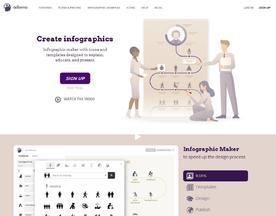
Infographic maker online - create professional infographics in...
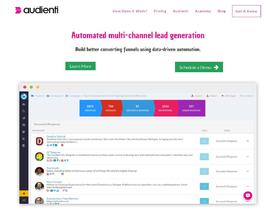
Audienti helps businesses get more traffic for their...

Casted is the only B2B Podcasting Platform. We...

ATOMIZED is Marketing Visualization & Collaboration software for...

Say goodbye to writer’s block. With Writesonic's AI-powered...

Search Engine Monitoring: How to Stay on Top of Your Online Presence
How to stay on top of your online presence with search engine monitoring? To stay on top of your online presence with search engine monitoring,

Press Release Example – The Complete Guide To Writing Your Own!
Alright, picture this – you’ve got a new business with a revolutionary new product lined up, ready to hit the market. You’re buzzing with excitement,

Content Marketing Automation: Complete Guide
In today’s digital landscape, content marketing is a critical component of any business strategy. However, creating and distributing high-quality and targeted content can be time-consuming

The Power of Video Content Marketing: Maximizing Engagement and ROI
Businesses can use video content marketing to promote their products, services, and brand. It entails making engaging and informative videos with the goal of attracting
Privacy Overview
- AI Content Shield
- AI KW Research
- AI Assistant
- SEO Optimizer
- AI KW Clustering
- Customer reviews
- The NLO Revolution
- Press Center
- Help Center
- Content Resources
- Facebook Group
A Clear Guide to Headings in Essays
Table of Contents
Whether to use headings in essay writing is a question of preference. Headings are standard for some written forms, such as report writing and case studies. But some lecturers prefer headings while others don’t want you to use headings in essays.
You must confirm the preference of your lecturer. Let’s explore more about the basic structure of essays and using headings in your essay writing.
Basic Structure of Academic Essay Writing
The majority of essays are written in continuous, flowing paragraphs without headings . At first glance, this could appear to be unorganized, yet good articles are meticulously structured.
Essays usually have no section headings. Only the title page, author declaration, and reference list have a heading. The basic structure of essay writing contains three parts:
Introduction
The following five components make up a typical introduction:
- An opening statement that grabs the reader’s attention.
- Background and contextual information on the topic.
- Include any important definitions where necessary.
- A brief outline of the key points, issues, theories, arguments, or other relevant information.
- A few sentences to explain your goals and objectives.
You must organize the body of the essay into paragraphs. And each section should address a different aspect of the issue.
However, it should also be connected to the ones before and after it in some way. This is a difficult task to master even for seasoned writers because there are a variety of effective ways to organize and combine paragraphs. There is no ideal or fixed template for a paragraph.
The conclusion of a paper should not introduce any new idea or information. Typically, there should only be one paragraph in the conclusion. It combines all the main points of your essay, so you don’t need to repeat the small detail unless you are emphasizing anything.
The conclusion is used to accomplish three things:
- Remind the audience of the purpose of your essay.
- Answer the question posed in the title, if possible.
- Remind your reader of how you arrived at your conclusion.

Headings in Essay Writing
If you do use headings, make sure to do so correctly and sensibly. Headings help readers to be able to find the differences between different sections without drifting off.
If you decide to use heading, then know that subheadings play an important role in your essay. It will not only capture the audience’s attention but also make the writing more visually catchy.
The subheading gives the essay a more organized appearance while refocusing the reader on its important parts. This subheading will provide a hint of what to expect in the content.
An essay can have subheadings if it is long enough to hold several sections with subtopics in each. However, subtitles must be compatible with the central theme and help to support the thesis of the essay. The recommended approach is to keep essay subheadings to 10 words.
Using headings in essay writing is not a convention, but it is not incorrect either. Whether or not to incorporate headings in your essay depends on the lecturer’s preference. This article explains the basic pattern of essay writing and how to use headings in your essays.

Abir Ghenaiet
Abir is a data analyst and researcher. Among her interests are artificial intelligence, machine learning, and natural language processing. As a humanitarian and educator, she actively supports women in tech and promotes diversity.
Explore All Blog Title Generator Articles
Why are headings used in articles.
As a writer, you should master everything about writing content. Your understanding of the profession reflects on the quality of…
- Blog Title Generator
How to Create a Good Title With Title Examples
Whether you’re writing a blog or a feature article, you NEED a good title. With a good title, you can…
Interesting Thesis Title Examples for Research Papers
Writing a research paper can be daunting. What’s even more challenging is picking a suitable topic. Even after brainstorming, you…
Best Tips for Writing a Great Blog
Anyone who has read a blog post has taken in information from a thought leader who is a pro in…
What Are Listicles? How to Start Them?
List posts, also known as lists, have a bad reputation in the online world, where the value of your blog’s…
How to Come up With Name Ideas for a Tech Blog
Do you want to build a successful tech blog? Are you looking for great tech blog name ideas to come…
Subtitles in an Essay: How to write Subtitles in Essays or Papers
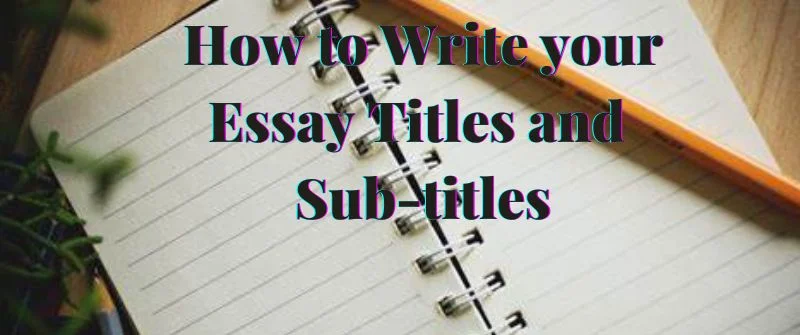
Do you need to know how to write titles and subtitles in essays effectively? The main secret is to ensure that the titles and subtitles you choose represent the content under them.
This article presents reliable ways that you can use to write titles and subtitles.
Can an Essay have Subtitles?
Essays can have subtitles because they are useful writing tools.

Subtitles direct the reader that the main heading has been divided into several parts. However, before using them, it is always important to inquire whether your subject discipline requires their use.
An essay can have subtitles if they help organize the thoughts, arguments and points into sectional topics that support the main thesis. Subtitles help the writer organize written work, especially if it involves a lot of words. Subheadings can be mini-essays because the writer is required to write their introduction, body, and conclusion before ending them.
Remember that subtitles must comprehend the main title because they can make a relevant piece of writing lose meaning.
How to Write Subtitles in an Essay or Paper
To write good essay subtitles, you need to do the following:
Come up with the Subtitles
To come up with effective subtitles, you need to understand the title of your essay clearly. The objective of the whole essay and the main points you want to put across should also be clear to avoid formulating subtitles that do not rhyme with your essay title.
In some essays, subtitles should be from the main to the minor. For example, if the title of your essay is “How the Covid-19 pandemic has affected the United States economy,” you should start with the main effects and proceed to the minor ones.
When formulating them, keep them arranged in this order for easy writing.
Write Clear Subtitles that are Straight to the Point

Subtitles should always be meaningful by themselves. The reader should not read the content to know what the subheading is but instead read the subtitle and know what to expect in the content.
This means that subtitles such as “introduction,” “body,” and “conclusion” should not be used in writing.
When the reader goes through the subheadings in your essays, they should know everything they are to expect concerning the thesis statement.
If there is no logical progression of ideas presented by your subtitles, then you have not arranged them properly, and the reader will likely get confused when going through them.
Write Short and Attention Grabbing Subtitles
Subtitles should always be short. They should only take a few seconds to read. Always try to make them as short as possible because you will explain them in detail.
However, always make sure that they make sense. There is no need to write short headlines if they do not make sense or clearly present what you will write about.
Subtitles should also grab the attention of the reader. Once they see them, they should have the urge to read what it is all about. Subtitles should use a smaller heading font than the main title and be bolded to differentiate them from the normal text.
Can an Essay have Titles
Essays should always have titles. Titles present what essays are all about hence giving the reader insight of what to expect when going through them.
An essay without a title cannot be said to be complete. Any cases of untitled essays must be allowed by the instructor or be in the instructions of the work provided.
How to Write Titles in an Essay
You must do the following to write effective titles for your essays.
Write the Title of the Essay after Writing the Content
You always have the title of your essay in mind as you are writing, but you should write it only after completing the text.
Only when you read the entire text will you be able to word the title correctly. This helps come up with a title that accurately presents what you have written and increases the chance of the title emphasizing what the thesis statement entails.
Always come up with similar titles, and from them, you can choose the most appropriate one for your essay.
Through brainstorming, you are sure that the chances of writing a title that does not go hand in hand are minimal.
Use an Academic Tone
A title of an essay should always have an academic tone that spreads throughout the whole paper. This is why we use third-person language and refrain from using personal opinions in papers or essays.
The language and word choice should depict persuasiveness and strictness and be informative. Any jargon should be avoided because essays are academic writings that are considered official documents.
Make it Catchy
Titles should always grab the attention of the reader. This is achieved by connecting with the reader immediately when they read the title.
This can be done by using questions, stating facts, and avoiding mysterious titles
Use Keywords
The title should contain the keywords in your essay. Both the title and the thesis statement should relay the same message.

Using keywords is also crucial in grabbing the attention of readers. Readers can know what to expect in an essay the most through keywords.
Make it Simple
Do not complicate an essay title. It is the first thing that the reader must easily understand.
Therefore, avoid using vocabulary may prevent the reader from directly grasping what your essay is all about
Follow the Format
Different writing formats require writers to write titles differently. Check out how to structure a paper and get a few things on the best format to use for term papers and research papers.
If formats are specified in the instructions, always follow their guidelines when writing a title. For example, APA format, MLS format, and the Chicago format have different ways of formulating a title, and using one instead of the recommended one can lead to essay failure.
Keep it Short and Accurate
A good title should always grab the reader’s attention without revealing the details of the essay. Even if no word limitations are provided, avoid making titles too long.
A title should always accurately represent what is in your essay and set expectations of what to learn in the essay.
About the Author: Pesh Pally

The Company
[email protected] +1 (213) 221-0069
Enjoy our 3-hour essay Help service
Yes, we deliver on such short deadlines. Our experienced essay writers will write your papers and assignments from scratch.
Just place an order via email and we will handle it for you. Send us an email.
© Copyright 2024 | All Rights Reserved | GradePals.com
Hey there! Free trials are available for Standard and Essentials plans. Start for free today.
What Is A Subheading and Why Are They Important?
Subheadings are extremely important, yet underutilized in formatting and SEO tools. Learn why you should optimize your subheadings and the best way to go about it.
A subheading is a mini-headline or text that is found under the main headline to give further insight or support for the headline. Headlines are used to entertain, add shock, or hook readers to make them want to know more, but the subheading guides the reader to keep reading or scanning the information.
A subhead is also designed to keep their attention. It can talk about the benefits someone will gain from the product or service. It can also further explain the headline. Most of all, a subheading will encourage readers to act.
A good subheading shows personality and creates curiosity. They should be useful and unique. Short subheads are best. The very first one should be the most engaging. Subheads should be used throughout the content to keep it scannable and readable. Subheads should keep things moving in a parallel structure. The length should also be similar. The best practice for effectiveness is to keep them at 70 characters or less within the content. Additionally, the subhead should keep things moving forward.
As a rule of thumb, when using subheadings, use just enough persuasion to keep them interested while telling them just enough. Subheads directly under the headline should be 10 to 30 words at the max. Most subheads are twice the length of the main headline.
What is a subheading?
When it comes to website building, subheadings help build the structure of a page. They help the content come together for clarity. Not only are they visually important but helps with navigation. On content pages, headings and subheadings are key.

Why are subheadings important?
A subheading improves the reading experience to enhance your search engine rankings. Subheadings contain keywords that directly affect your SEO. Headings carry more weight than normal text, but most people don’t know that.
While every subheading doesn’t need to have a keyword, there should be at least one or two. This helps the search engines filter through to find text associated with your topic. Here are some important factors:
- Know when to use subheadings
- Pay attention to the heading’s levels. They differ in the hierarchy of information.
- Use them to separate topics.
- Keep them simple.
There are some common mistakes writers make when writing subheads:
- Not giving enough thought to crafting the section. It’s important to consider what the section is about, the most important part of the section, and what the reader should be gaining from reading the section. This helps in creating a subheading that delivers value to the reader, such as how to do something, or what they will learn. They should know what to expect from the rest of the section.
- Not being clear and focusing too much on being creative. Being creative is good, but if it will confuse the reader, it’s a no-go. Make sure the reader has a good explanation of what you are saying. Your goal is to deliver solutions, not confusion.
- Being inconsistent with structure. You want to have a consistent pattern in your content. The main headline and subheads are one, two, three, and four.
- Straying from the topic. The subhead should always connect back to the main heading, This keeps the consistency and does not confuse the reader. Every subheading should delve deeper into the content while remaining attached to the headline.
The big three: headline, subheading, and CTA
While each of these elements holds its own weight, they all work best when presented together. Subheads make the headlines stronger, and a CTA brings everything together. Here’s a good formula:
- Headline – Make them look twice
- Subhead – Pull them in to seek more information
- Call-to-Action – Tell them what to do next.
The headline is what readers see first on a webpage, blog, article, etc. It should make a powerful enough statement that the reader is intrigued. They should be excited or something that really grabs attention.
The subhead draws the reader in further, giving them something to think about. They should want to read more. This is through explaining, discussing the benefits the reader will get or how their life will improve, or encouraging action in some way. The subhead should directly feed off the headline.

The call-to-action brings it all home. The header starts things off, the subhead keeps them reading, and the CTA is the logical ending. You don’t want to leave the readers hanging, wondering what they should be doing next – tell them.
How to write the best subheadings
Writing the best subheads takes practice. Here are a few tips:
Focus on the organization
How you organize the content is key. It should be logical enough to help the reader understand. The phrases should have keywords and have natural links, not stuffed. It should flow and make sense as it builds and the readers continue through the content. This may not always make sense, but there is another structure that may be useful. Summarize the big takeaways before they start reading, and then highlight certain phrases, ideas, or stats throughout the content.
Separate the content
Once you organize and lay everything out, your headings and subheadings are important. Make sure the headings are specific and descriptive. The subheadings should be distinguishable and describe all the information that follows. This should be a seamless experience for the reader that will keep them there. The goal is to have them read more of your content, act, purchase or donate.

Make the headings and subheadings clear
Most website users will not read every word on your page. Many will scroll through the subheadings to see which sections are relevant to them, their needs, or the question they are trying to answer. This is important to keep in mind when writing, because even if you have the information they are searching for in the body, if they can’t find it in a quick scan they might leave your site for another. So, distinguish the heading from the subheading for the reader. That means the size of the content, in some cases, the color, the font, effects, or a combination of these. Depending on specific style guides, each one will be different.
The shorter, the better
No one wants to read a long winded subheading. Readers like content that is straight to the point. Keep this in mind when you are writing and cut any unneeded filler words. With that said, longer subheadings are fine in some instances, especially if you are squeezing in a longtail keyword. It's important to keep the length of your headings consistent throughout the content. Avoid having a mix of short and long headings as they will stand out and potentially distract readers.
Use graphics
Similar to subheadings, graphics are something that many users look for when reading a blog or scrolling through a company's website . Depending on the type of content it is, graphics can further enhance the value you give to your readers. Imagery through graphics, grids, graphs, or pictures can make a huge difference in further explaining the content.
Keep your brand voice consistent
Establish your brand voice early on in your business strategy as it’s a critical part of cultivating brand awareness and brand loyalty. Once you find the right tone for your brand, it’s important to remain consistent across all channels, social platforms, and throughout your content—including in your subheadings. For example, if you strive for a tone that is more professional, you don’t want to catch your audience off guard by including more casual wording in your subheaders.
Don’t underestimate the power of good subheadings
You want to have an idea of good copywriting subheadings that sell. What makes a subheading sell? To get big results from your text, you should look at the subhead as a roadmap. The job is to get the reader wanting to skim the content and keep the reader engaged and focused on what you wrote. Using an all-in-one platform like Mailchimp can help put things together in the right way while marketing your business.
A strong subhead is an ad of sorts for the very next section. That means you’re highlighting the benefits they are getting from acquiring knowledge. They will intrigue and inform the readers, and they will push them to a result because they used the information they got from your content. Think of a subhead as a story that your reader wants to read multiple times and possibly share.
Let the facts of your subhead speak and make it personal. When crafting strong headlines and subheads, put yourself in the reader’s shoes. Think about the features of what you’re writing about and what you would want to know, or what you would want people to think.
It’s so important to have subheadings that make it count. Teams should prioritize wireframing their websites with headings and subheadings following a hierarchy and the benefits of what they stand to gain. The personality of the brand should shine through without being too creative. Short and to the point can also provide creativity when done the right way.
Don’t neglect the power of SEO and how it helps your content in the search engines. Be thoughtful in the writing so the subheading can have a strong CTA. Remember, each subheading’s content should tie directly back to the headline.
Separate your content to create a seamless flow from start to finish. Make the subheading clear on what the section will be about. Your readers should not have to worry. On websites, subheadings work very well with an image, headline, and subheading. This helps reinforce the message of what they should be expecting.
Using the right platform can help. Mailchimp helps create better content with their content studio and AI-powered solutions. Their testing tools and insight can help act the right way that makes a difference. For more, check out Mailchimp today.
Related Topics
- Landing Pages
- Build a Website
- Buy a Domain
- Drive Website Traffic
- Analyze Website Performance
- Optimize for Mobile

IMAGES
VIDEO
COMMENTS
Headings and subheadings appear at the beginning of a section and organize the flow of the documents. In addition, they are both used to break down large blocks of text to make them more scannable. They also have a hierarchy that is Heading (H2) first, followed by subheadings (H3) and (H4) in that order.
The APA 7.0 formatting guidelines for headings and subheadings are based on a five-level hierarchy, with each level indicating the level of importance and hierarchy of information. Level 1 headings are the highest level, followed by Level 2, Level 3, and so on. Each level has a specific formatting style, such as font size, boldness, and ...
Headings and subheadings provide structure to a document. They signal what each section. is about and allow for easy navigation of the document. APA headings have five possible levels. Each heading level is formatted differently. Note: Title case simply means that you should capitalize the first word, words with four or more letters, and all ...
An essay consists of three basic parts: Introduction. Body. Conclusion. The essay itself usually has no section headings. Only the title page, author declaration and reference list are written as headings, along with, for example, appendices. Check any task instructions, and your course or unit handbook, for further details.
Books. MLA does not have a prescribed system of headings for books (for more information on headings, please see page 146 in the MLA Style Manual and Guide to Scholarly Publishing, 3rd edition).If you are only using one level of headings, meaning that all of the sections are distinct and parallel and have no additional sections that fit within them, MLA recommends that these sections resemble ...
Although shorter essays are written in continuous, flowing, and paragraphed texts and do not need subheadings, longer essays are carefully structured using headings and subheadings. An essay or research paper can have headings and subheadings (subtopics) if it is long enough to accommodate different sections.
The paper or chapter title is the first level of heading, and it must be the most prominent. Headings should be styled in descending order of prominence. After the first level, the other headings are subheadings—that is, they are subordinate. Font styling and size are used to signal prominence. In general, a boldface, larger font indicates ...
enhancement." In other cases, once you have the key pieces of your argument in place, you will be able to remove the subheadings. Strategy #3: Create a reverse outline from your draft While you may have learned to outline a paper before writing a draft, this step is often difficult because our ideas develop as we write.
At the outset, make a plan for how you will deal with matters of capitalization, formatting and sequencing of headings. Headings at the same level should be formatted the same. For instance, "Section 2.2" should get the same treatment as "Section 4.1". They should also have parallel structure.
APA style headings example structure. Level 1 Centered, Bold, Title Case. Text begins as a new paragraph. Level 2 Left-aligned, Bold, Title Case. Text begins as a new paragraph. Level 3 Left-aligned, Bold Italic, Title Case. Text begins as a new paragraph. Level 4 Indented, Bold, Title Case, Period. Text begins on the same.
There are five levels of heading in APA Style. Level 1 is the highest or main level of heading, Level 2 is a subheading of Level 1, Level 3 is a subheading of Level 2, and so on through Levels 4 and 5. The number of headings to use in a paper depends on the length and complexity of the work. If only one level of heading is needed, use Level 1.
APA Style uses a unique headings system to separate and classify paper sections. Headings are used to help guide the reader through a document. The levels are organized by levels of subordination, and each section of the paper should start with the highest level of heading. There are 5 heading levels in APA. Regardless of the number of levels ...
have completed your essay. Your title is not your thesis statement, it just outlines the topic. It can oftenbe more creative in tone. TIP In the Humanities,essays do not traditionally have subheadings, only reports do. However, for those in sciencefields, subheadings are encouragedfor various writing styles. Every assessment is designed ...
Some longer essays may require subheadings which should also be left-aligned. Indents - no indents on first lines of paragraphs are needed. ... Shorter quotations in the text do not need to be italicised and should have double-quotations marks "like this" to indicate they are direct quotations. Longer quotations (what counts as this differs ...
An essay can have subheadings or subtopics if it is long enough to accommodate many parts with subtopics in each part. However, the subtopics and subtitles must be consistent with the overall topic by contributing to prove the thesis of the essay. If necessary, the best practice is to limit essay subheadings to 10 words.
Many students wonder about this, especially those just beginning to write essays. Fortunately, the answer is "yes" - your essay does have subheadings and other divisions within the essay. Subtopics can be used to organize the material in longer essays. Before you start thinking about writing the body of your essay, it is important to ...
A subheading is a secondary title that divides content into sections, making it easier to read and navigate. Subheadings are an essential part of any written content, whether it's a research paper, a news article, or a blog post. They are used to break up the text into smaller, more manageable sections, making it easier for the reader to ...
An essay subheading can act in both ways of the descriptions mentioned above, depending on how the sub-heading is used in your paper. Proper use of essay subheadings is a process that builds bridges and can make your essay flow from start to end. Essay writing is easy when a well-written essay subheading is used.
An essay can have subheadings otherwise subtopics if it is large enough to accommodate many parts equipped subtopics in each part. However, one subtopics and subtitles must be consistent with the overall topic on contribution to prove the thesis of aforementioned essay. If necessary, an best practice shall to limit essay subheadings to 10 speech.
This subheading will provide a hint of what to expect in the content. An essay can have subheadings if it is long enough to hold several sections with subtopics in each. However, subtitles must be compatible with the central theme and help to support the thesis of the essay. The recommended approach is to keep essay subheadings to 10 words ...
The objective of the whole essay and the main points you want to put across should also be clear to avoid formulating subtitles that do not rhyme with your essay title. In some essays, subtitles should be from the main to the minor. For example, if the title of your essay is "How the Covid-19 pandemic has affected the United States economy ...
3. Include keywords and phrases. Once you have a general idea of what subheadings apply to your writing, you can examine where to include keywords. For example, if you were writing an article about baking a cake, it might include keywords like "cake" or "baking." Besides including keywords, you can also incorporate key phrases like "baking a ...
Be thoughtful in the writing so the subheading can have a strong CTA. Remember, each subheading's content should tie directly back to the headline. Separate your content to create a seamless flow from start to finish. Make the subheading clear on what the section will be about. Your readers should not have to worry. On websites, subheadings ...
I have an essay due next week on the history and impact of a federal law, 21 U.S.C. S856, which outlaws the operation of any building where drugs are made or used. ... some with subheadings like ...